Search optimization has entered a new era — one driven by artificial intelligence. With algorithms evolving faster than ever, you now need more than manual keyword research and guesswork to stay competitive. AI-powered SEO tools have become essential for understanding search intent, improving content quality, and ensuring your pages rank where it matters most — on the first page of Google.
Here’s the reality: more than 50% of all website traffic still comes from organic search, and nearly 75% of users never scroll past the first page. That means your visibility, engagement, and growth depend on how intelligently you optimize your content. But keeping up with constant algorithm updates, content velocity, and technical changes can be overwhelming without the right support.
That’s where the Best AI SEO tools come in. These platforms analyze data faster than any team could, revealing the right keywords, entities, and structure needed to outperform competitors. They help you write content that resonates with both search engines and real readers — blending analytics with authentic storytelling.
In this guide, we’ve handpicked the top 5 AI SEO tools based on innovation, usability, and proven impact on rankings. You’ll learn how each tool helps you plan smarter, create faster, and optimize every page for lasting visibility.
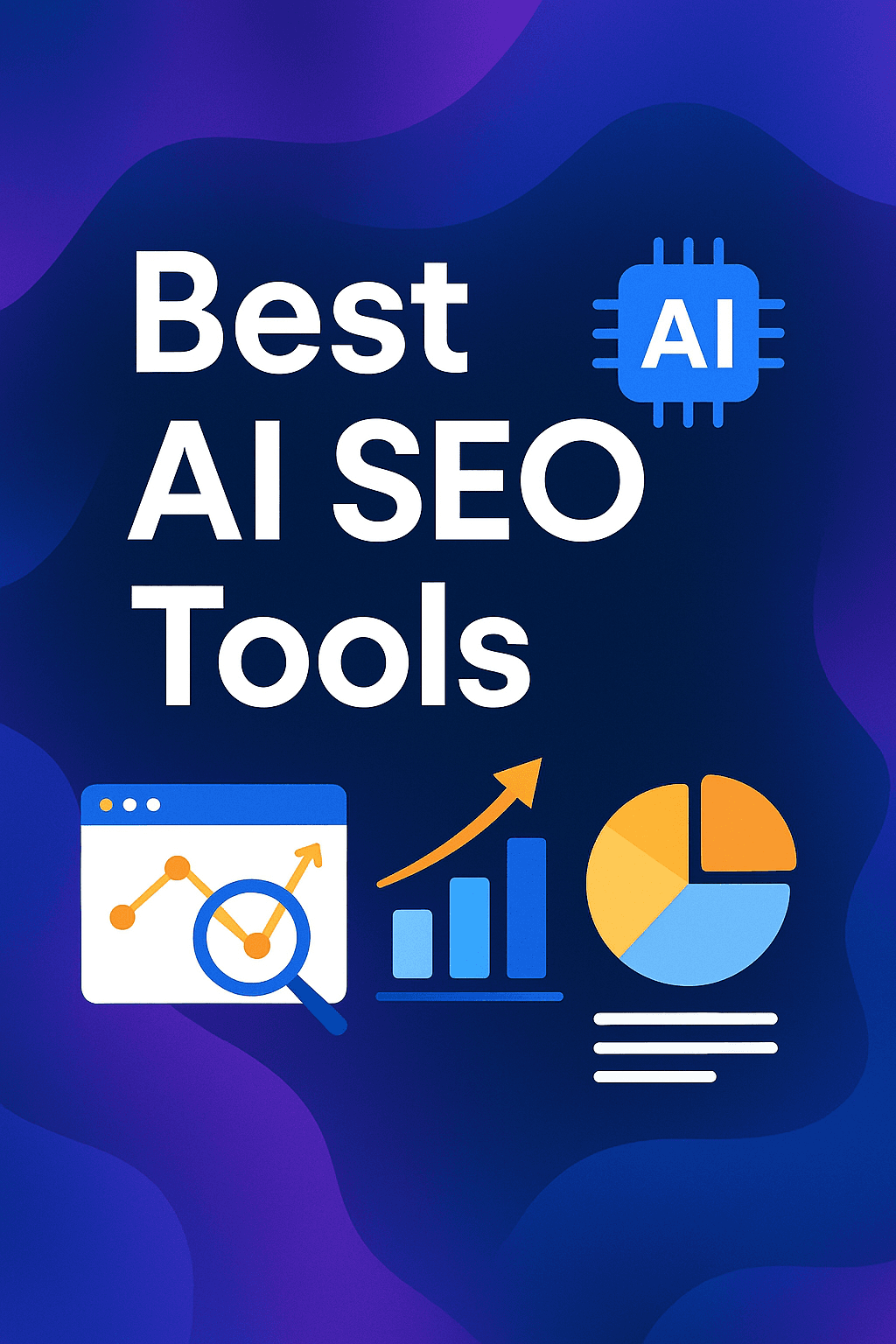
Best AI SEO Tools
AISEO – Best Overall AI SEO Tool
Semrush AI Toolkit – Best for Advanced SEO Analytics
SurferSEO – Best for On-Page Optimization
Keyword Insights – Best for Topic Clustering & Content Strategy
SEOwind – Best for AI-Generated Briefs & Content Research
Writesonic– Best Platform That Takes You from Tracking to Action to Results
AirOps- Best for Automating SEO Operations and Content Workflows at Scale
Rankscale.ai — Best for Precision Tracking for AI Search Visibility
Clearscope- Best for Human-Centered SEO Optimization
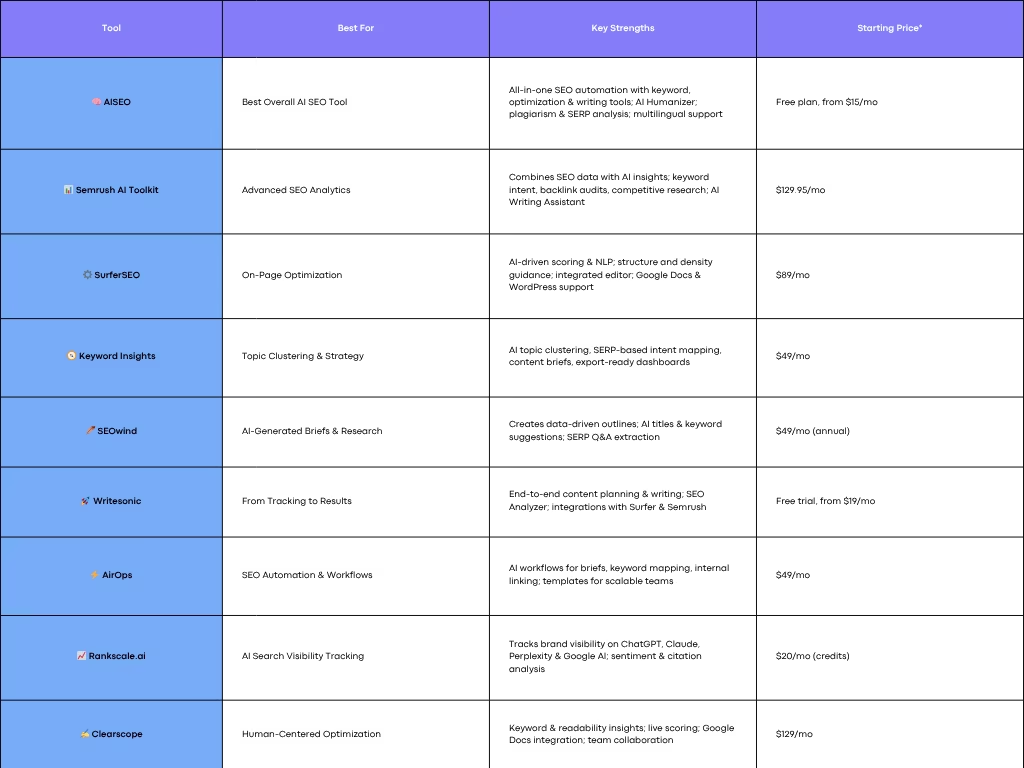
AISEO – Best Overall AI SEO Tool
If there’s one tool redefining how content ranks in search, it’s AISEO. Unlike most AI SEO tools that focus on just keyword stuffing or automated writing, AISEO approaches SEO holistically — blending content optimization, AI humanization, plagiarism fixing, and topical authority building under one roof.
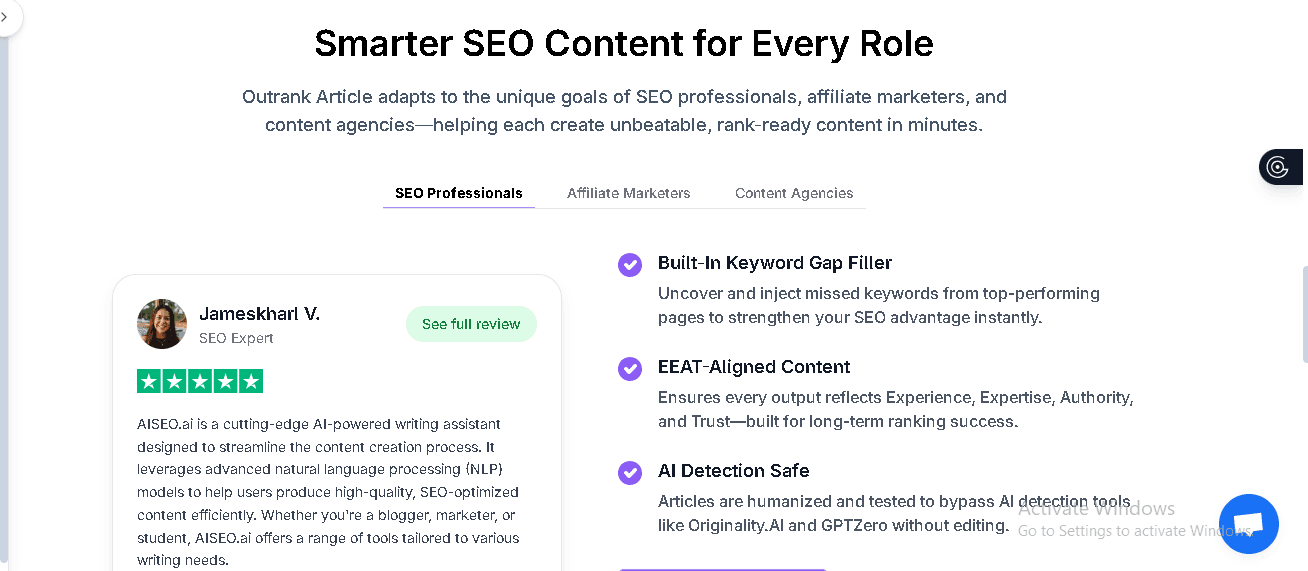
AISEO bridges the gap between AI automation and genuine human readability. Its built-in AI Humanizer ensures your writing passes every major AI detector, from GPTZero to Copyleaks, while the Generative Engine Optimization (GEO) suite enhances how your content performs in search engines powered by large language models (LLMs) like ChatGPT, Gemini, and Claude.
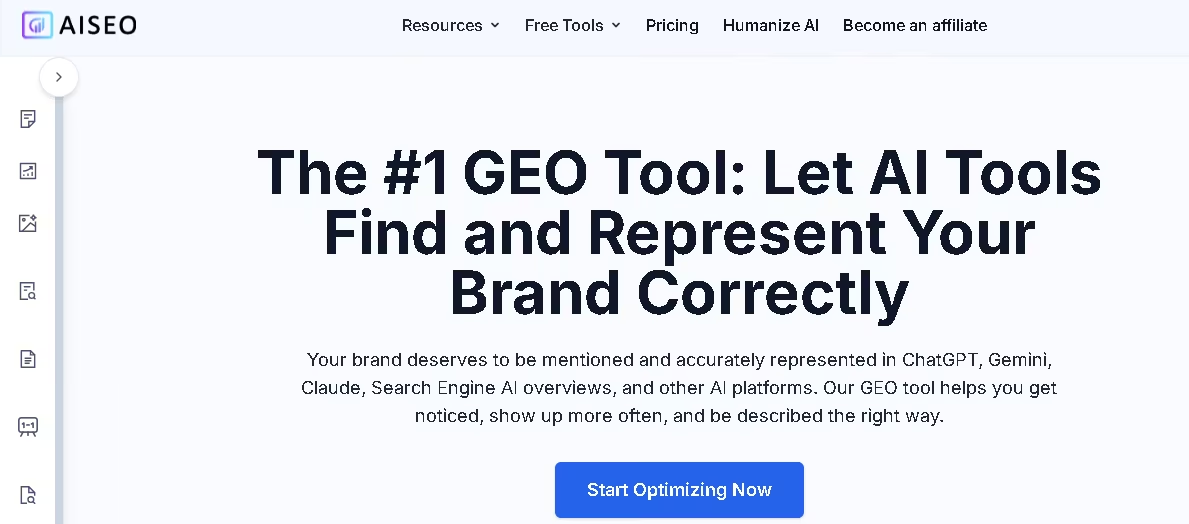
In other words, AISEO doesn’t just help you rank on Google — it helps you rank inside AI answers, too.
During testing, AISEO consistently reduced editing time by up to 70%, delivered higher engagement metrics, and produced human-grade writing that retained keyword accuracy and intent clarity. Whether you’re a solo content creator, a growing brand, or an SEO agency, AISEO provides everything you need to create, optimize, and dominate search results.

🧠 Core SEO Tools
AISEO’s foundation is built on a powerful suite of core SEO tools designed to handle everything from keyword tracking to content quality assurance. These features ensure that every piece of content you publish is optimized not just for search engines — but also for humans and AI-driven platforms.
AI Grader
Before you hit publish, AISEO’s AI Grader evaluates your content’s SEO performance and readability. It assesses on-page factors like keyword placement, structure, and tone, while also checking if your writing sounds human. You’ll get a clear grade (A–F style) with actionable recommendations — helping you fix weak areas instantly and ensure your post meets both algorithmic and audience expectations.

Keyword Rank Checker
This feature lets you track your target keywords in real time across Google’s search results. It shows where your content currently ranks, how it’s performing over time, and where competitors might be outranking you. With this insight, you can fine-tune your strategy to capture higher visibility and traffic.
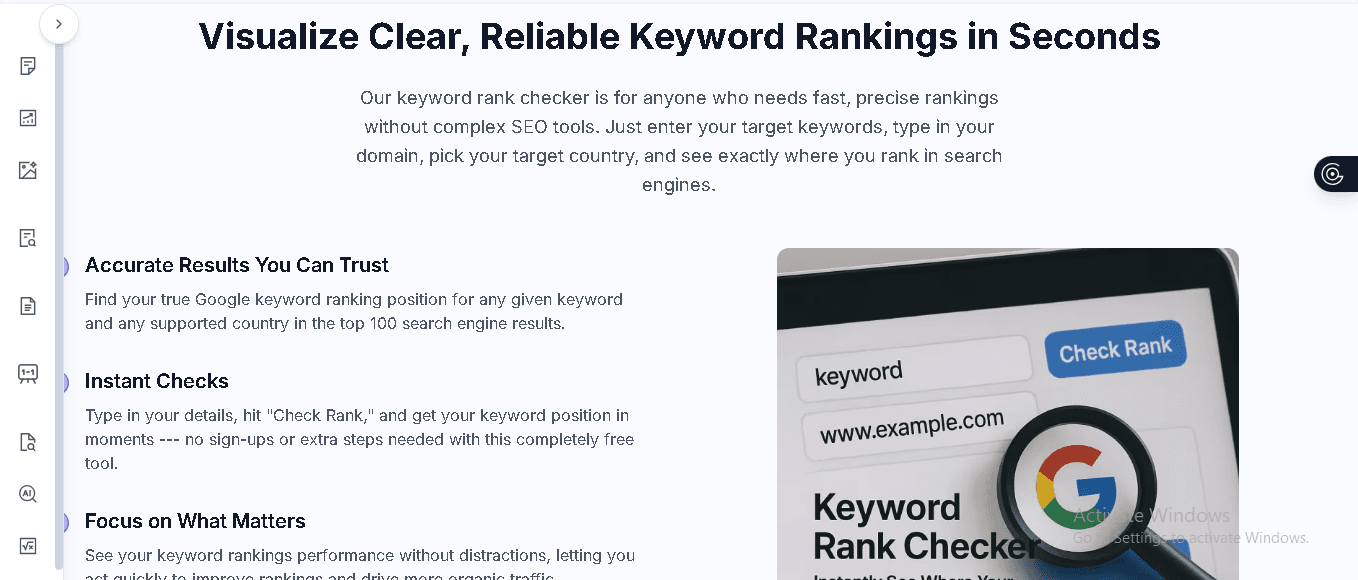
Competitor Keywords
AISEO’s Competitor Keywords tool reveals the search terms driving traffic to your competitors’ pages. It’s like getting a peek into their SEO playbook — allowing you to target the same keywords or find overlooked ones to strengthen your edge. This feature is especially useful when planning new content or refreshing underperforming pages.

SEO Ranking Checker
Think of this as your website’s performance dashboard. It tracks rankings for all your published pages, monitors fluctuations, and provides visibility reports that show which URLs are climbing, holding, or dropping in SERPs. It’s an essential feature for keeping your SEO progress measurable and transparent.
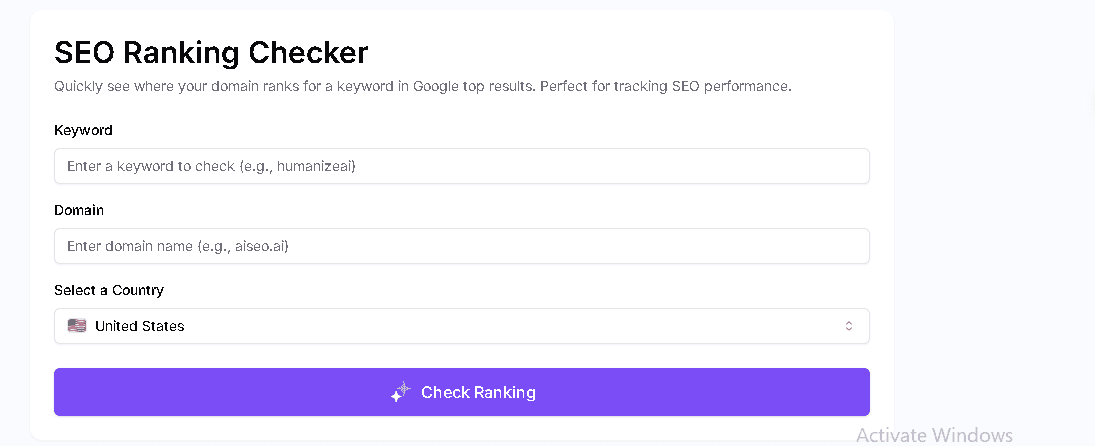
Keyword Density Checker
Over-optimized content can kill your rankings. The Keyword Density Checker ensures you’re using keywords naturally throughout your content. It analyzes keyword frequency, placement, and context — making sure your content remains SEO-friendly while still sounding authentic and easy to read.
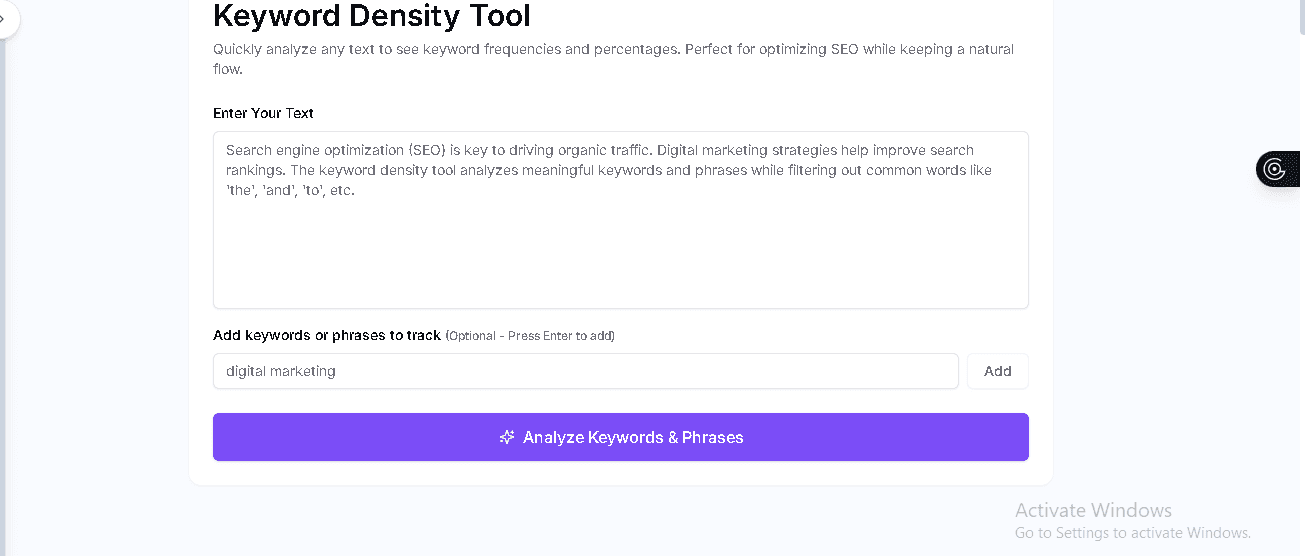
Plagiarism Checker
Duplicate content can damage credibility and SEO authority. AISEO’s Plagiarism Checker scans your drafts across millions of online sources, detecting copied material or phrasing overlaps. It then suggests unique rewrites that preserve meaning but eliminate duplication, ensuring originality in every post.

AI Detector
AI-generated content can sometimes sound robotic — and search engines are catching on. The AI Detector verifies that your writing feels human, natural, and engaging before publishing. It scores your text for “human-likeness” and even provides tips to improve tone, flow, and variation — helping your content safely pass AI detection tools like GPTZero, Turnitin, and Copyleaks.
Pricing
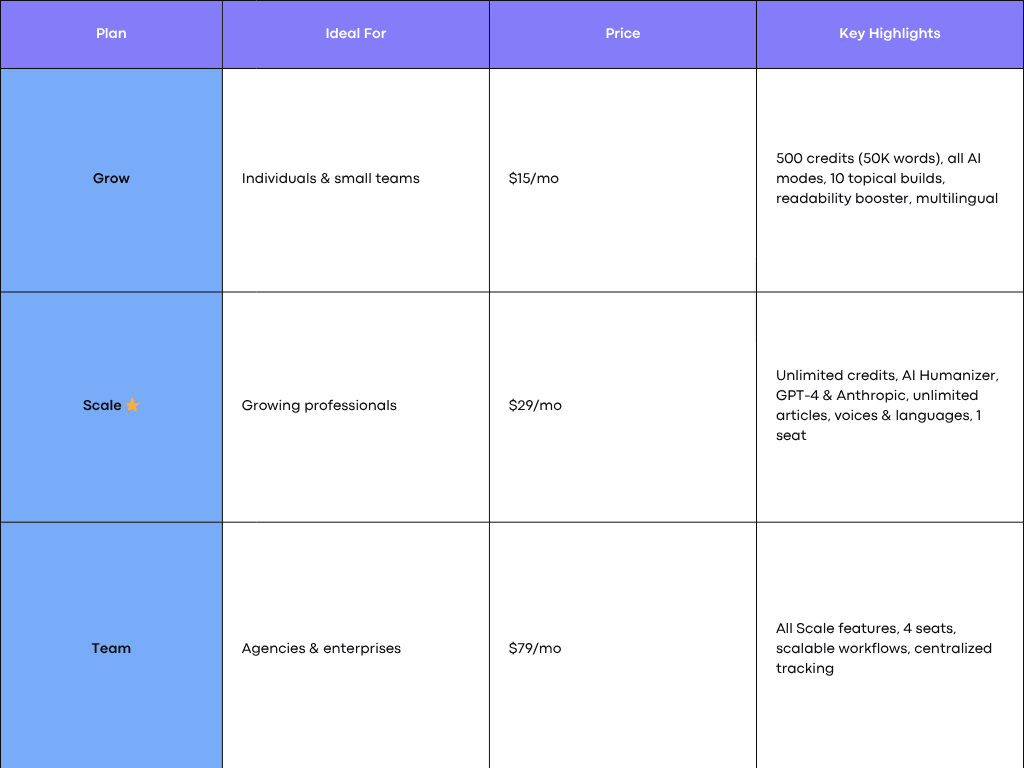
Both plans include AI Detector Evasion, Humanize Files (DOC, PDF, PPT), and Truly Undetectable Content—making AISEO a must-have if your goal is to produce scalable, human-level SEO content.
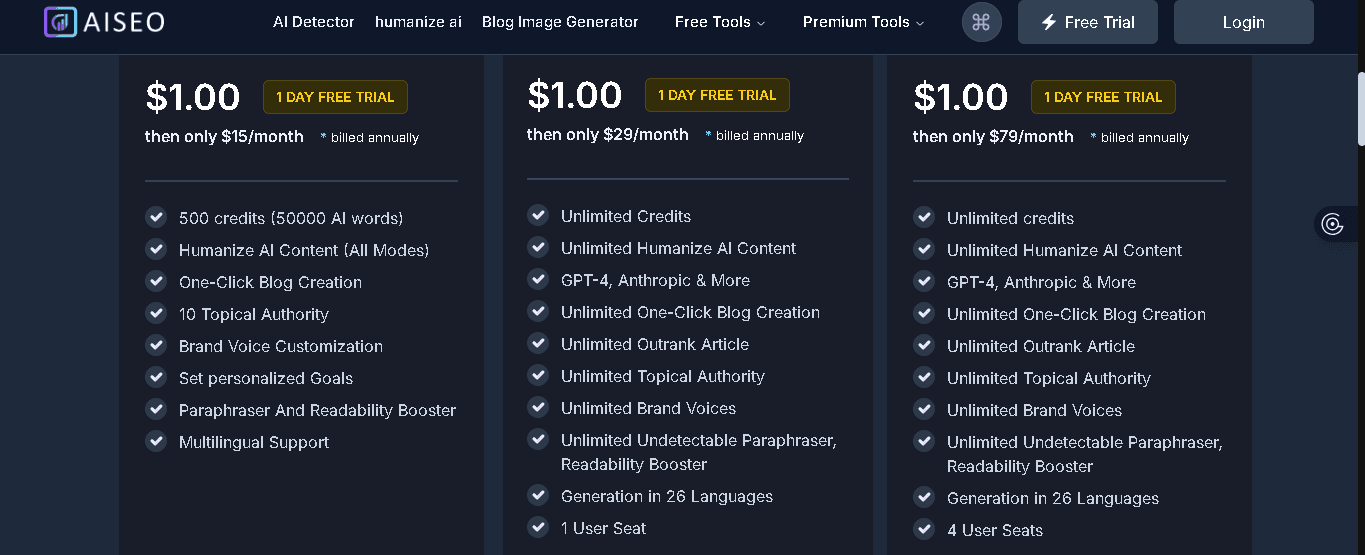
Semrush
If you’re serious about dominating search results, Semrush is one of the first tools you’ll hear about — and for good reason. It’s not just an SEO tool; it’s an entire digital visibility ecosystem trusted by over 10 million marketing professionals and 35% of Fortune 500 companies, including global giants like Shopify, Amazon, and FedEx.

Semrush gives you everything you need to analyze, optimize, and expand your brand’s online footprint — all powered by one of the largest AI-driven marketing databases in the world. With over 25 billion keywords, 43 trillion backlinks, and 808 million domain profiles, it offers unparalleled data depth to help you make smarter decisions, faster.
What sets Semrush apart is its ability to connect every part of your SEO strategy — from keyword discovery and site audits to content writing, link building, and competitive analysis. You don’t just track rankings; you understand why you rank and how to move higher.

🧠 Core SEO Features of Semrush
1. Keyword Research & Strategy
Semrush’s keyword research toolkit is one of the most comprehensive in the industry. It gives you access to over 25 billion keywords across 142 global databases, allowing you to uncover new opportunities in any market or language. The Keyword Magic Tool helps you identify search intent, difficulty, and long-tail variations in seconds.
You can even build topic clusters and monitor keyword trends over time. Whether you’re optimizing a single blog post or designing a full content strategy, Semrush ensures your keyword choices align with both audience demand and SEO potential.
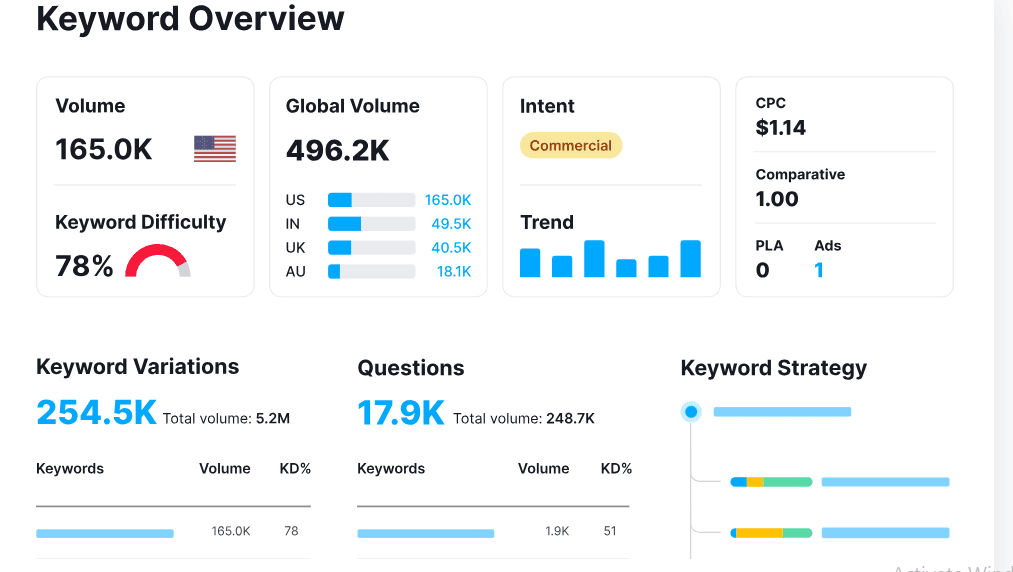
2. Competitive & Backlink Analysis
Understanding your competition is key to outperforming them — and that’s where Semrush shines. With 43 trillion backlinks and 808 million domain profiles, its Backlink Analytics and Domain Overview tools reveal exactly how competitors are driving traffic. You can track new and lost links, compare domain authority, and identify which referring domains have the biggest impact on rankings.
The Backlink Gap feature pinpoints the sites linking to your competitors but not to you, creating instant outreach opportunities. This data-driven insight helps you build a stronger, more authoritative link profile that boosts visibility and trust.
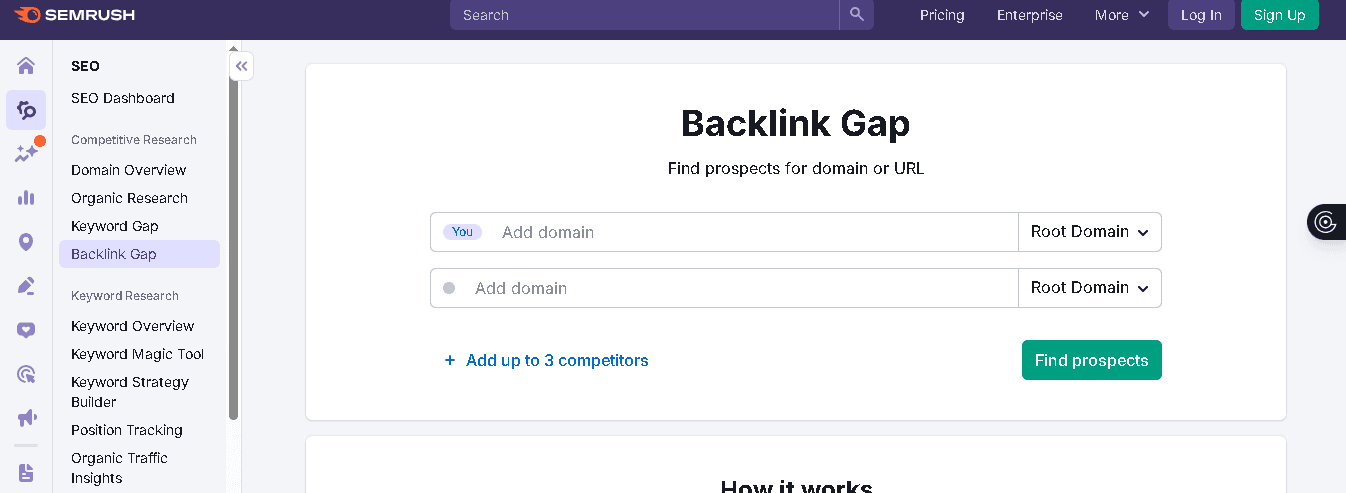
3. Site Audit & Technical SEO
Semrush’s Site Audit tool acts like a digital health check for your website. It crawls every page to detect over 140+ SEO issues, from broken links and duplicate content to crawl errors, HTTPS problems, and slow-loading pages. You’ll also receive actionable recommendations for improving site performance and user experience.
The integrated Log File Analyzer helps you understand how search engines crawl your site, ensuring no critical page goes unnoticed. Together, these tools make it simple to optimize technical SEO, enhance site speed, and improve indexability — essential for ranking higher on Google.
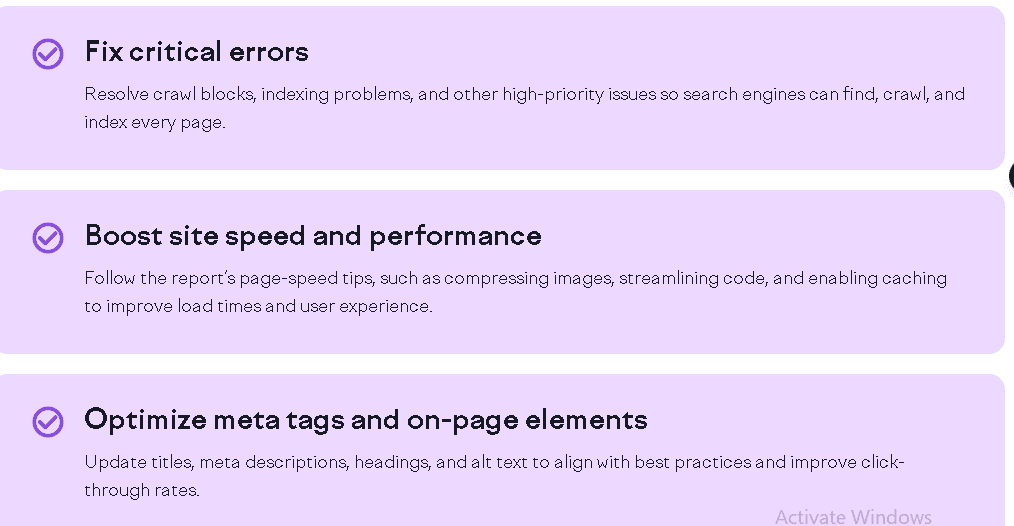
4. AI Visibility & Brand Monitoring
In a world shifting toward AI-driven discovery, Semrush’s AI Visibility and Brand Monitoring tools give you insights beyond traditional SEO. They track how often your brand appears in AI search platforms like ChatGPT, Perplexity, and Google’s AI Overviews. You can measure brand mentions, sentiment, and share of voice across multiple digital channels, ensuring you stay visible where consumers are searching today.
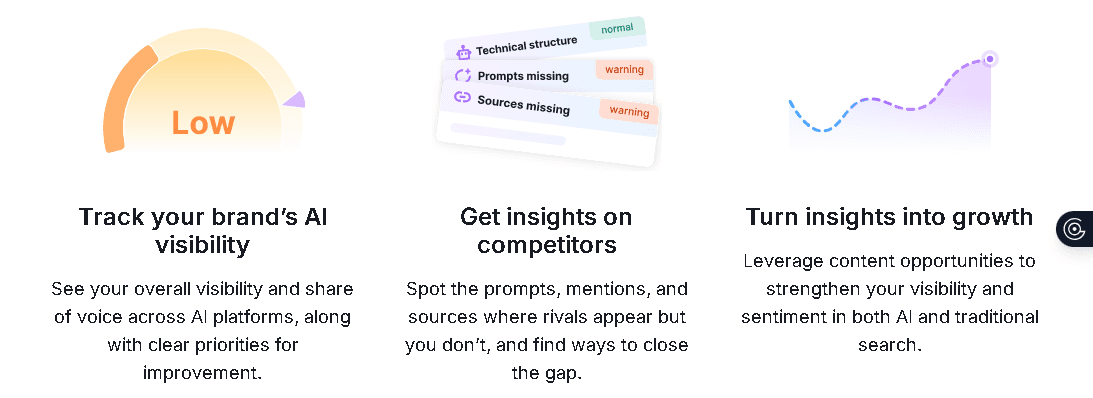
By combining SEO data with AI visibility metrics, Semrush helps you future-proof your marketing strategy, keeping your brand top-of-mind in both search results and emerging AI ecosystems.
Pricing
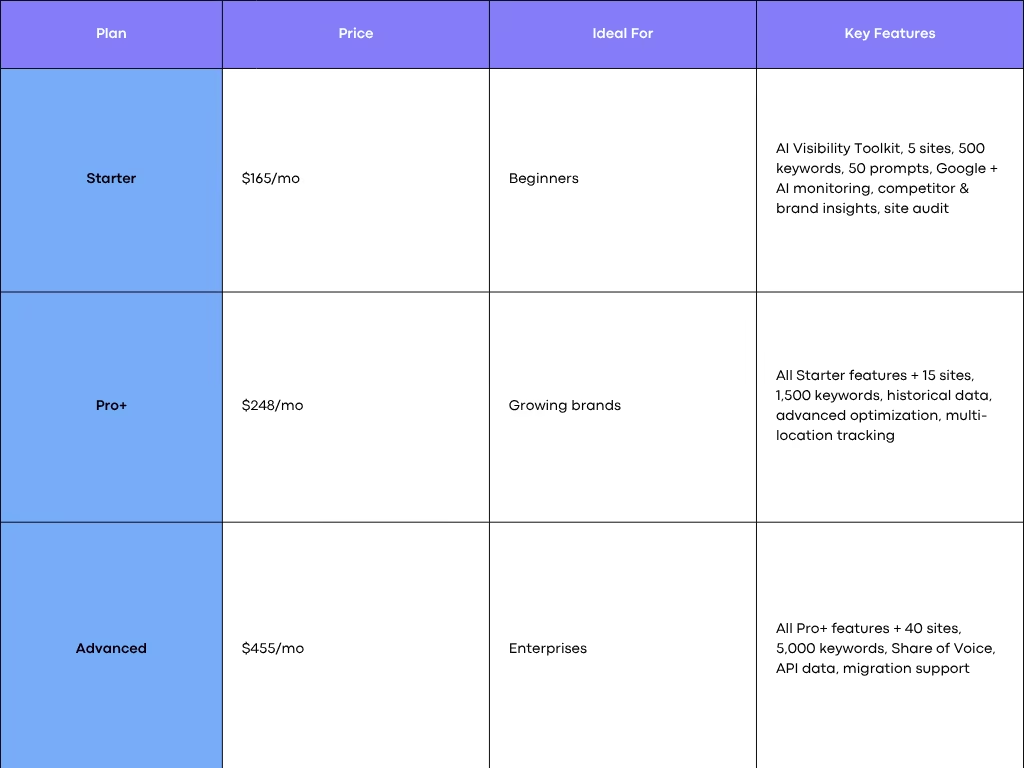
Semrush offers a 7-day free trial, so you can explore its full capabilities risk-free before committing.

SurferSEO
Search has evolved — and so has SurferSEO. Today, visibility isn’t just about Google; it’s also about AI-powered search assistants like ChatGPT and Perplexity. SurferSEO helps you create, optimize, and humanize your content so it performs across both traditional and AI search ecosystems. Its unique workflow aligns your content with Google’s ranking factors and AI comprehension models, ensuring your brand stays discoverable in every search environment.
Over 150,000+ content creators, SEOs, and agencies already trust SurferSEO to write, optimize, and scale faster than ever.
🧠 Core SEO Features
1. Unified Search Optimization
SurferSEO lets you optimize for Google and AI search engines side by side. You no longer need separate tools to target traditional blue-link rankings and AI-generated answers. The system aligns your content with the keywords, entities, and context that both Google and LLMs rely on. Surfer’s Recommendations engine highlights trending topics and user intents that frequently appear in AI answer platforms, helping you fill gaps in your topical coverage.
By publishing content aligned with these recommendations, your website earns stronger topical authority and increases its chances of being cited or surfaced in AI-generated responses.

2. Topical Map & Recommendations
Surfer’s Topical Map visualizes your website’s current authority and content gaps. It shows which subject clusters you already dominate and which related topics could strengthen your expertise. This tool is essential for entity-based SEO, as AI search platforms like ChatGPT prioritize authoritative, niche-specific domains.
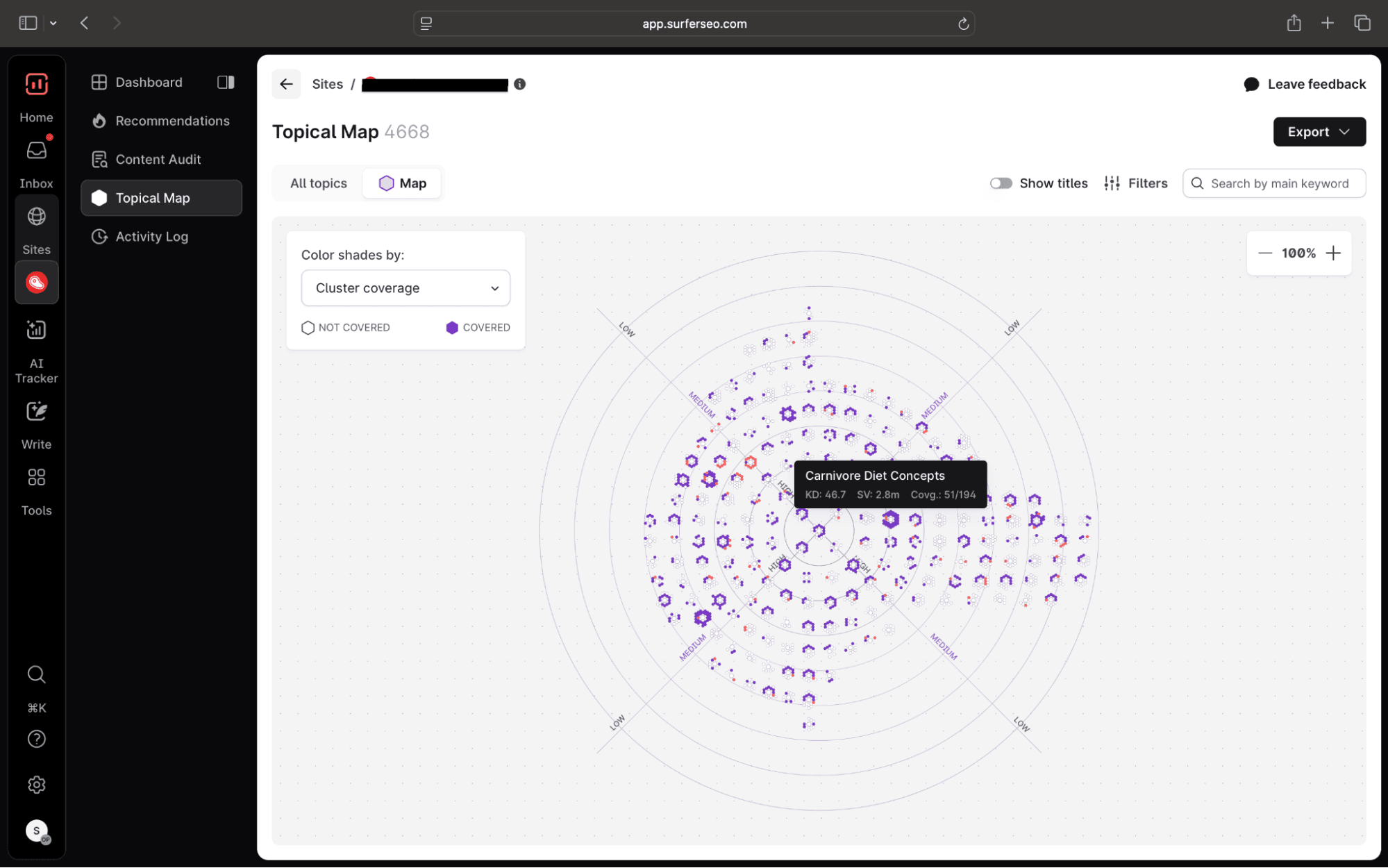
Surfer’s Recommendations system complements this by suggesting new topics your audience — and AI users — are asking about. Together, these tools help you plan high-impact content calendars that expand your digital footprint across both organic search and conversational AI platforms like Google SGE, ChatGPT, and Perplexity.
3. AI Tracker & Visibility Metrics
The AI Tracker is one of SurferSEO’s most exciting innovations. It measures your visibility across AI-generated results using three core metrics:
- Mention Rate — how often your brand or pages appear in AI-generated answers.
- Average Position — your ranking position compared to other sources in AI results.
- Visibility Score — a composite metric reflecting your total exposure across major LLM platforms.

You can even track competitors and analyze how often their content appears in ChatGPT or Perplexity. Surfer also lets you add custom prompts to track — giving you control over which AI queries you want your brand to appear in.
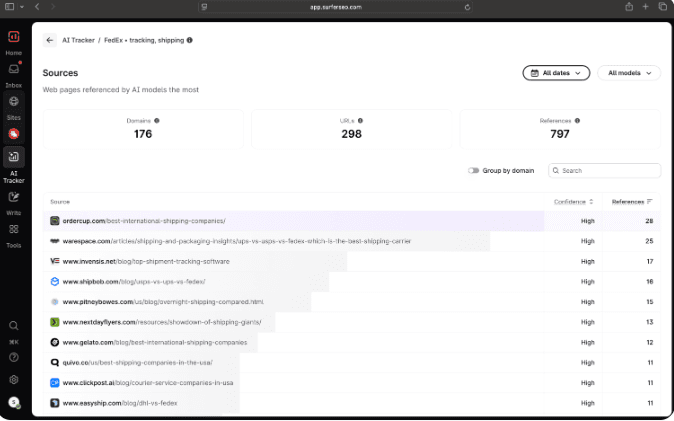
Pricing — SurferSEO Plans
SurferSEO’s pricing is designed for every growth stage — whether you’re an individual creator, a scaling team, or an enterprise managing large-scale content and AI visibility.
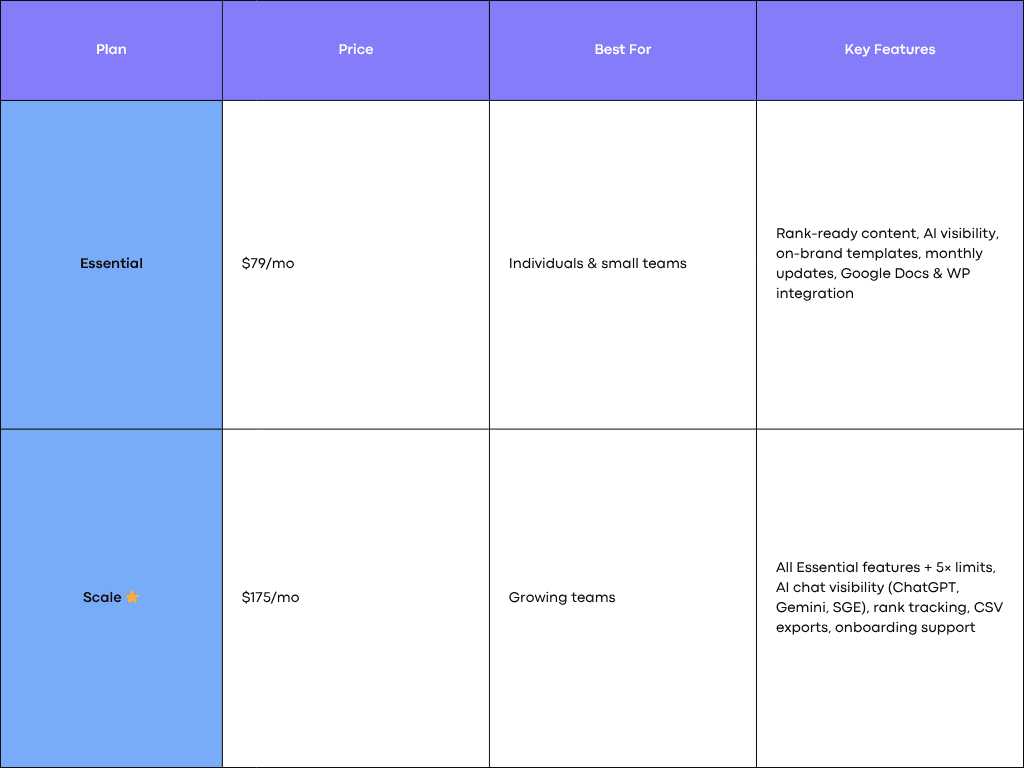
🧾 Quick Summary
- Essential – Start building your organic and AI search presence effortlessly.
- Scale – Multiply results and dominate both SERPs and AI-driven queries.
- Enterprise – Unlock full control, deep analytics, and white-labeled SEO intelligence.

Keyword Insights
Keyword Insights is not your average keyword research tool — it’s a content strategy powerhouse designed for SEOs who think in topics, not just terms. In the new AI-driven world of search, it’s no longer about ranking for one keyword; it’s about owning an entire subject.

What makes Keyword Insights special is its SERP-based clustering technology. Instead of grouping keywords by phrases, it studies Google’s top 10 results for each query and clusters those that share ranking URLs. This means every keyword cluster is backed by real user intent — not assumptions. The result? A content plan that builds topical authority, prevents keyword cannibalization, and helps your brand dominate both Google SERPs and AI-generated answers.
🧠 Core SEO Features
1. Keyword Discovery
Keyword Insights begins with powerful keyword discovery that combines sources like Google Autocomplete, Reddit, and People Also Ask. You can upload your own keyword lists or analyze your domain to identify existing ranking opportunities. What stands out is its ability to surface fresh, trending queries that reflect real search intent in real time. T
his makes it ideal for dynamic niches like tech, eCommerce, and AI. The only caveat is that its competition score relies on CPC data, which is better suited for paid ads than organic SEO difficulty. Still, for discovery and topical mapping, it’s impressively thorough.
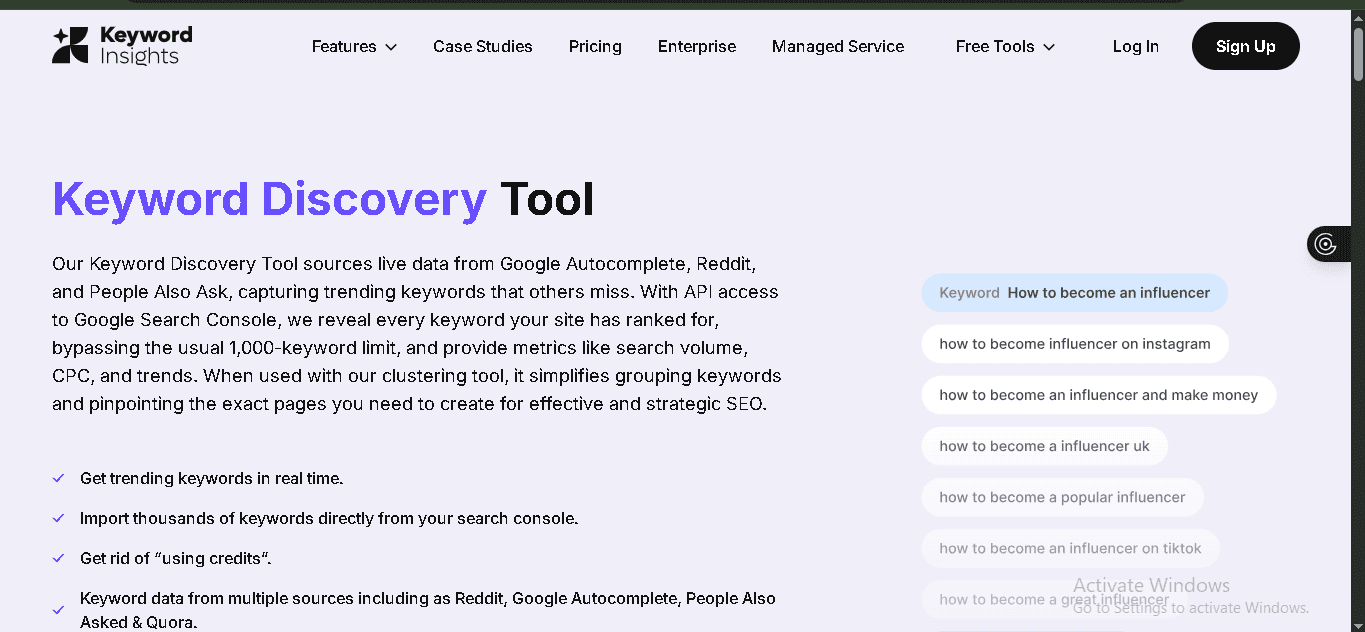
2. Keyword Clustering (The Star Feature)
This is the beating heart of Keyword Insights. Using SERP Overlap analysis, it examines top-ranking URLs across multiple keywords and groups those with similar results into one cluster. For example, if “best running shoes for men” and “top men’s running footwear” share 7 of the same ranking pages, they’re combined under one content hub.
This data-backed clustering method eliminates guesswork and prevents keyword cannibalization, a common issue in large content libraries. The accuracy of this SERP-based system consistently scores between 70–95/100 — far higher than AI-only or pattern-matching models used by competitors.

3. Search Intent Identification
Each keyword cluster is automatically labeled with its primary search intent — Informational, Commercial, Transactional, or Navigational. This ensures that your content format aligns perfectly with what users expect. For instance, an Informational cluster may require a blog post or how-to guide, while a Commercial cluster calls for a product comparison or landing page. In one case study, simply aligning content to intent boosted traffic by 341%.
This automated intent detection ensures every piece of content hits the right tone, structure, and purpose — without needing to manually evaluate thousands of keywords.
4. Content Briefs & AI Writer Assistant
Once your clusters are built, Keyword Insights helps you move from data to execution. Its AI-powered Content Brief Generator pulls headings, PAAs, and competitor structures from live SERPs. It then feeds this data into the AI Writer Assistant, which helps you draft, expand, or refine content directly from those briefs.

It’s not a “1-click article generator” — rather, a collaborative assistant that accelerates writing while keeping human creativity intact. With structured briefs, smarter prompts, and integrated topic data, teams can produce consistent, SEO-aligned content at scale while saving up to 50% of their usual research time.
Pricing
Keyword Insights follows a flexible, credit-based model that scales with your workflow. Each action — from keyword clustering to SERP analysis — consumes credits, so you pay only for what you use.
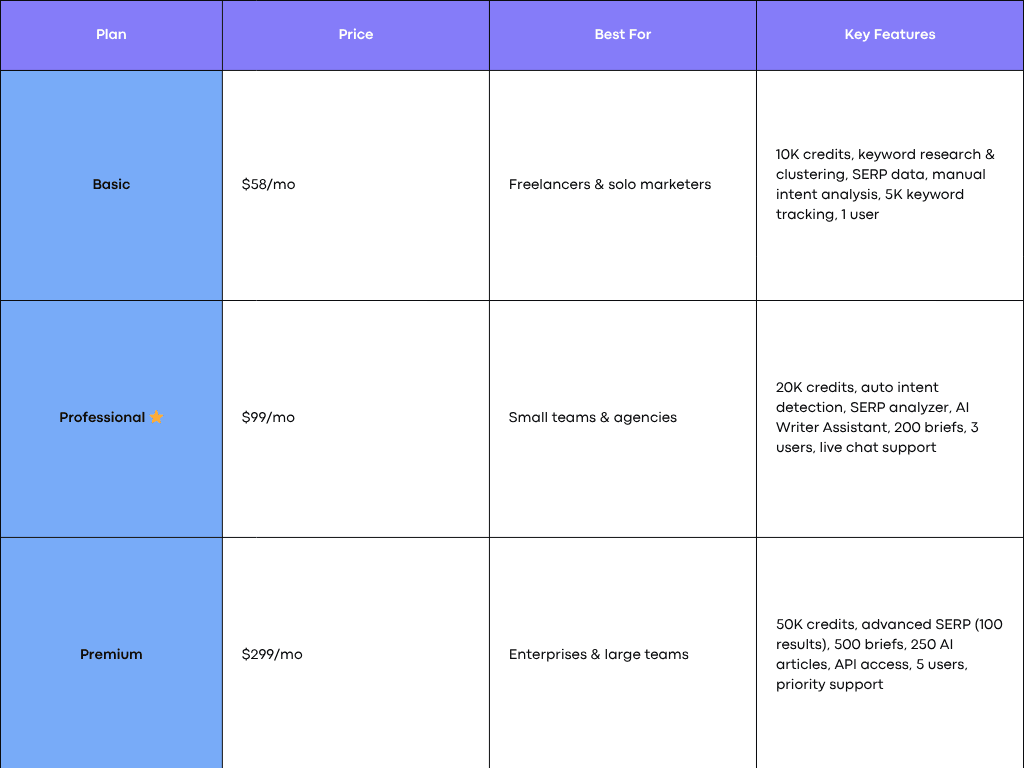
⚙️ How Credits Work
- 1 keyword = 1 credit for discovery or clustering
- 1 content brief = 100 credits
- 1 article = 200 credits
Credits reset monthly and can be topped up as needed

SEOwind – Best for AI-Generated Briefs & Content Research
SEOwind isn’t just an AI content generator — it’s a growth engine built to scale organic visibility using data-driven content briefs, EEAT-optimized writing, and automation. Designed for agencies and marketing teams, SEOwind combines AI research, automation, and expert strategy to create and update content that performs across both Google search and AI-powered Overviews (like ChatGPT or Gemini).
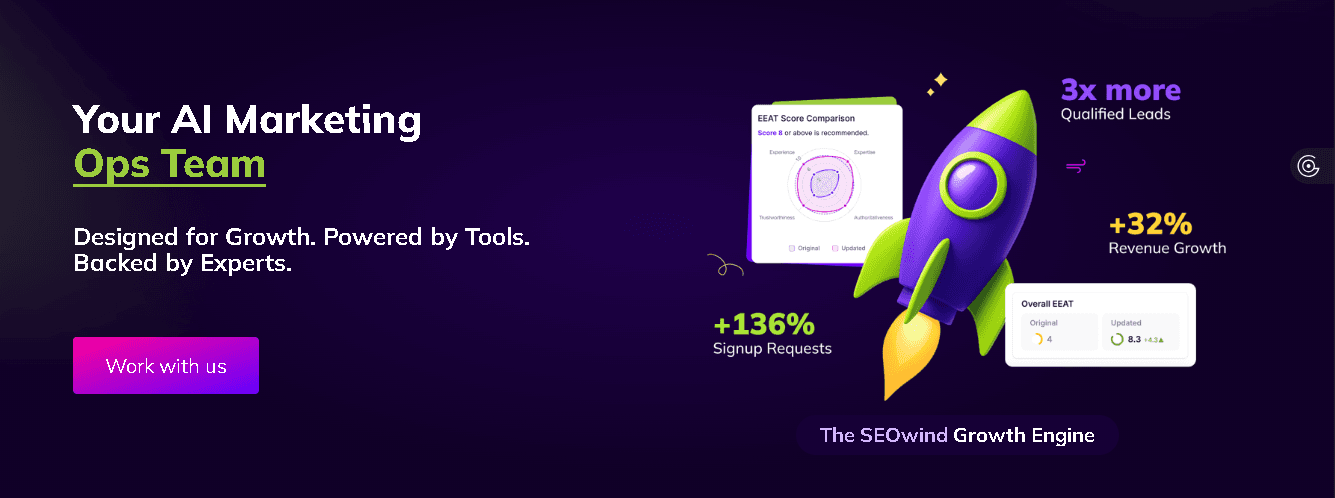
Instead of simply writing with AI, SEOwind helps you plan, build, and maintain a full content system — from research to publishing — with human guidance at every step.
🧠 Core SEO Features
1. Smart Brief Generator
SEOwind’s Smart Brief Generator is its backbone. It analyzes live SERP data, keywords, and competitor pages to build detailed content outlines within minutes. Each brief includes top-ranking headings, relevant subtopics, People Also Ask questions, and internal linking ideas.
Unlike generic AI tools, SEOwind’s briefs are tailored to user intent and EEAT standards, ensuring your content aligns with what search engines value most. The result? Clear direction for writers and faster turnaround from concept to publish-ready articles — all backed by real-time search data.

2. AI Article Writer
SEOwind’s AI Writer blends automation with human oversight to create EEAT-ready content. It uses your brief to generate drafts that match your tone, style, and SEO goals. The writer incorporates factual data, competitor benchmarks, and internal linking suggestions. For teams that manage large content calendars, this feature is a huge time-saver.
It maintains brand consistency, adapts to context, and uses AI humanization to ensure every article reads naturally while staying compliant with search algorithms. It’s not just AI writing — it’s content built to rank.

3. Content Update Engine
SEOwind’s Content Update Engine helps you revive underperforming pages with precision. It scans your existing articles, identifies ranking drops, and compares your content against current SERP leaders. Using intent and keyword analysis, it recommends updates that can quickly boost visibility — from new sections to improved headings and internal links.
This feature is invaluable for maintaining long-term SEO success and making sure older content doesn’t get buried. With the update engine, your blog or website evolves continuously alongside search trends.

4. EEAT & Quality Scoring
One of SEOwind’s most innovative features is its EEAT and quality scoring system. Each draft is evaluated for expertise, experience, authoritativeness, and trustworthiness — the same signals Google uses to assess content reliability. The tool then offers recommendations to improve those scores, such as adding expert quotes, structured data, or external references.
By quantifying content quality, SEOwind turns abstract SEO principles into measurable improvements. This data-driven approach helps writers and editors consistently produce credible, ranking-worthy material that appeals to both search engines and human readers.

Pricing
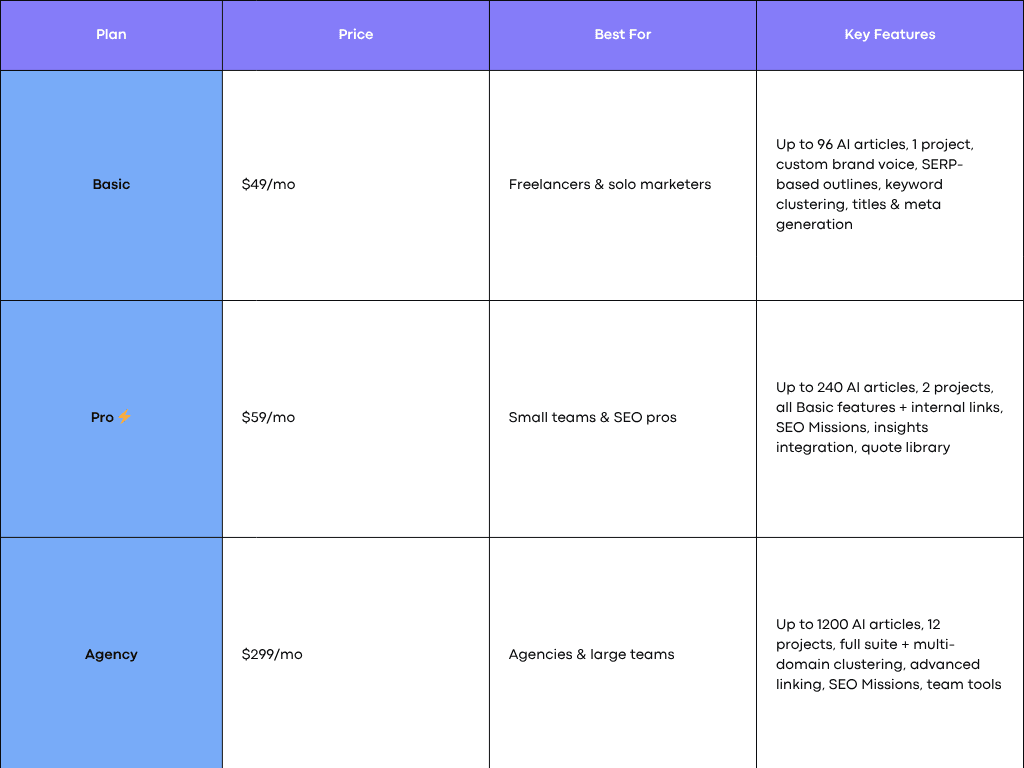
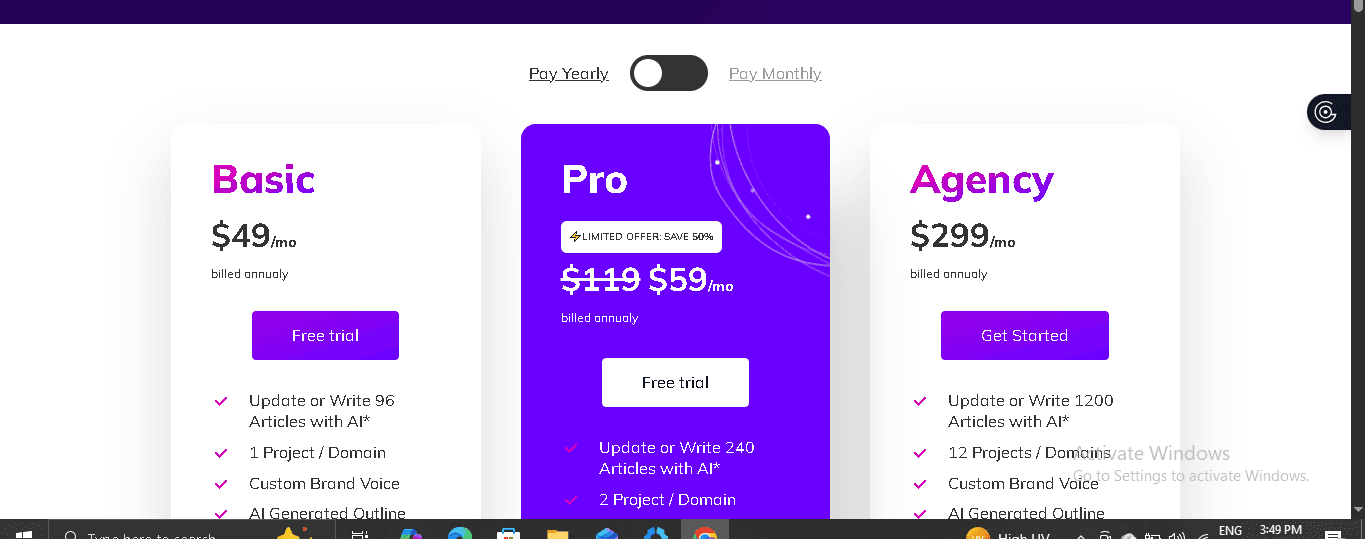
Writesonic
Writesonic is one of the most versatile AI SEO tools designed to take you from idea generation to publication—all in one platform. Think of it as a blend of Semrush’s Content Toolkit and SurferSEO’s AI Writer, but with extra capabilities like AI chatbots, humanizers, and built-in SEO optimizers.
It’s made for content marketers, SEO teams, and growing businesses that want to research keywords, write optimized articles, and track performance without juggling multiple tools. The real standout? Writesonic helps you measure AI visibility—showing how your brand appears in AI-generated search results across ChatGPT, Gemini, and other AI models.
Get started free with no credit card, and start transforming your content pipeline—from tracking to tangible SEO results.
⚙️ Key Features of Writesonic
1. AI Visibility Tracking
Writesonic helps you go beyond keyword rankings by showing how your brand performs in AI-generated search results. You can:
- Track mentions and visibility in ChatGPT, Gemini, and AI search engines
- See which competitors are being cited more often
- Identify platforms where AI conversations reference your industry but not your brand
- Monitor brand sentiment and share of voice across multiple platforms
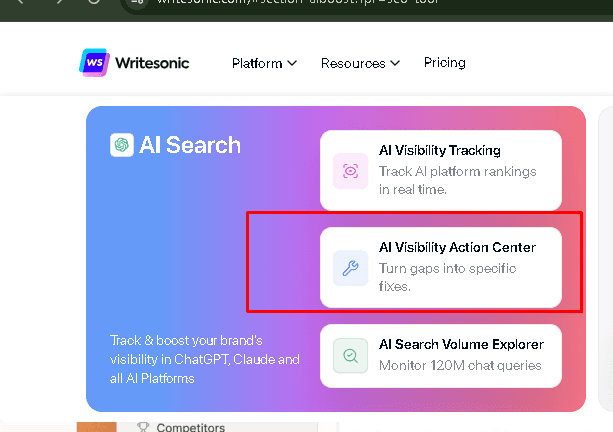
This kind of visibility insight is groundbreaking—it tells you not just where you rank, but why AI models recommend your competitors over you.
2. SEO Engine & Technical Automation
Writesonic integrates with Ahrefs, Semrush, and Google Search Console, even if you don’t have your own subscriptions. You can:
- Analyze live competitor data and keyword intent
- Run full site audits and detect broken links, schema issues, and crawl errors
- Get AI-generated fix suggestions for technical SEO without developer support
- Receive real-time ranking recommendations based on live SERP data

It’s a one-stop shop for maintaining your site’s health while optimizing for both Google and AI-driven search models.
3. Content Engine & AI Writing Tools
Writesonic’s writing suite goes beyond just generating text—it builds content that ranks and reads naturally. You can use:
- AI Article Writer 6.0 to produce long-form content up to 5,000 words
- AI Outliner for auto-generated content structures based on top-ranking SERPs
- Content Brief Generator for research-backed, SEO-optimized outlines
- AI Humanizer to rewrite and humanize your text, bypassing AI detection
- AI Rewriter and Readability Enhancer to fine-tune tone, flow, and structure
Each output is EEAT-ready, fact-checked, and designed to align with your brand voice for consistent tone across articles, blogs, and social media posts.
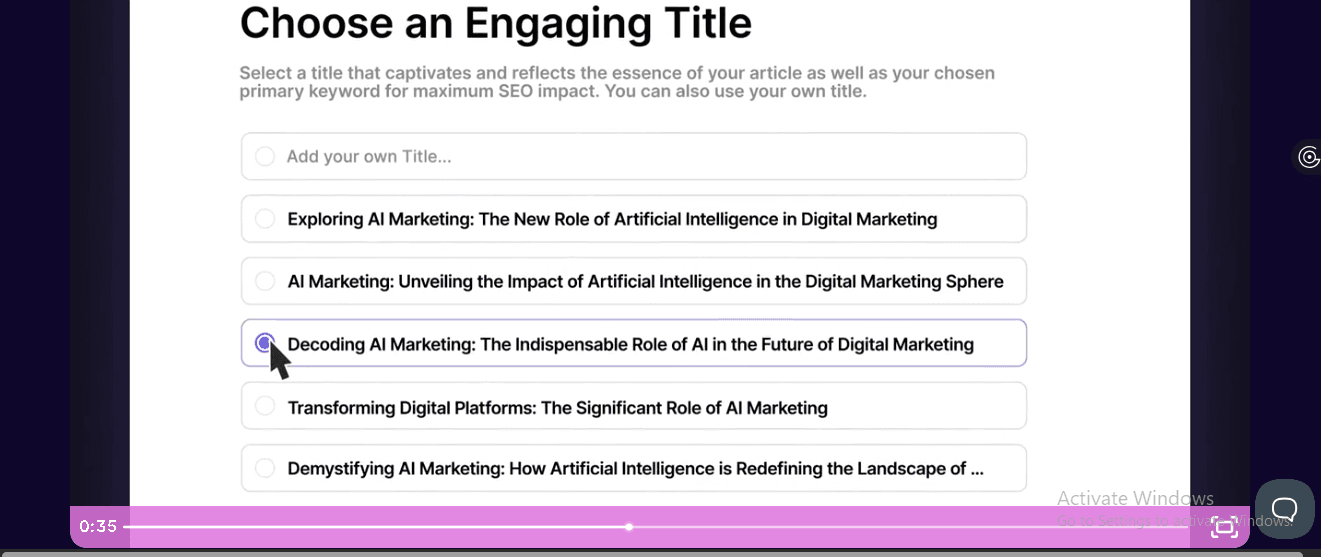
4. AI Content Optimization
Writesonic’s SEO Checker and Optimizer evaluates your content in real time—just like SurferSEO or ContentShake AI. It provides actionable recommendations for:
- Keyword density and missing semantic terms
- Readability, structure, and metadata
- Internal linking and content gap analysis
- Fact validation and external citation opportunities
The result? Content that not only ranks but stays relevant as algorithms evolve.

5. Content Publishing and Repurposing
Push your final articles directly to WordPress or export them to CMS tools in one click. You can also repurpose blog content into:
- Social media posts
- Newsletters
- Landing page copy
- AI-generated summaries and infographics
Writesonic’s Botsonic tool even allows you to build your own AI chatbot, so visitors can interact with your brand content conversationally.

6. Real AI Search Data — Not Just Keywords
Forget traditional keyword volume metrics—Writesonic shows what people are actually asking across AI platforms. With access to a proprietary dataset of over 120 million AI chatbot conversations, you can:
- Discover trending natural language prompts
- Identify real search intent behind AI user questions
- Predict AI search volume across multiple models (ChatGPT, Google AI Mode, Gemini)
- Use these insights to shape content that’s relevant for AI-driven visibility
This makes Writesonic a true bridge between SEO and generative AI analytics—a crucial advantage in 2025.

Writesonic Pricing Table
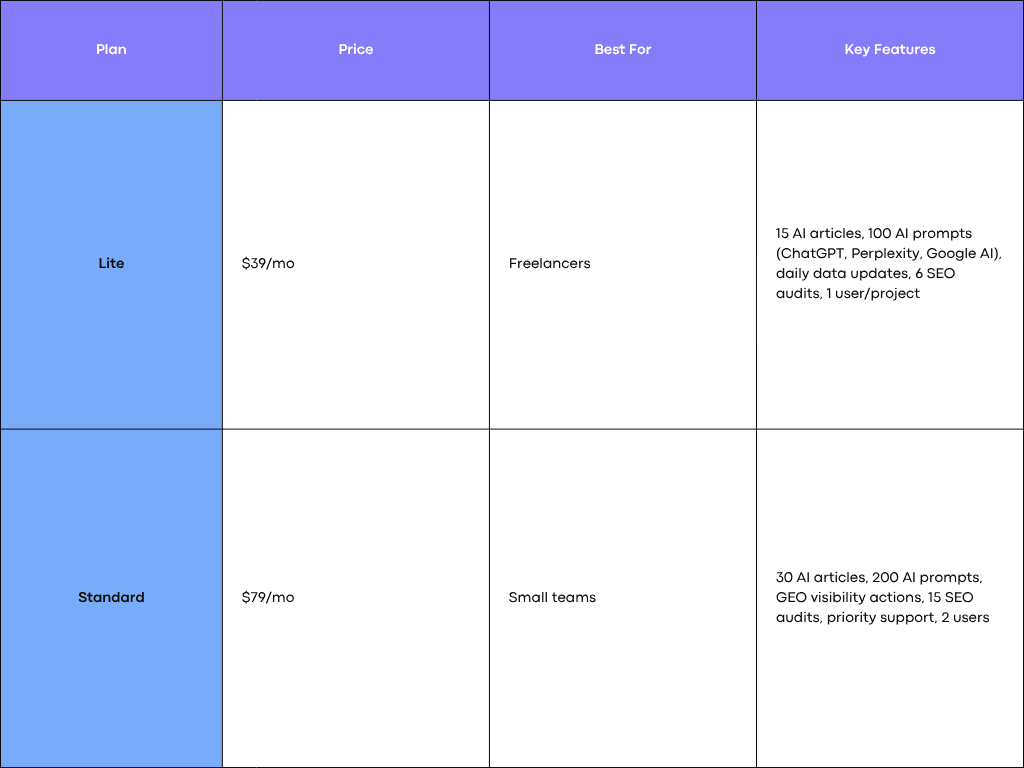

AirOps
AirOps is a powerful, customizable AI content operations platform that helps marketing teams and agencies automate their SEO and content workflows from one intuitive dashboard. It combines the intelligence of GPT-4, Claude, and Gemini with flexible templates, real-time SEO data, and seamless integrations — allowing you to generate, optimize, and publish content without extra headcount.
Unlike basic AI writers, AirOps acts as your SEO command center, giving you complete control over how your content is researched, structured, and published.
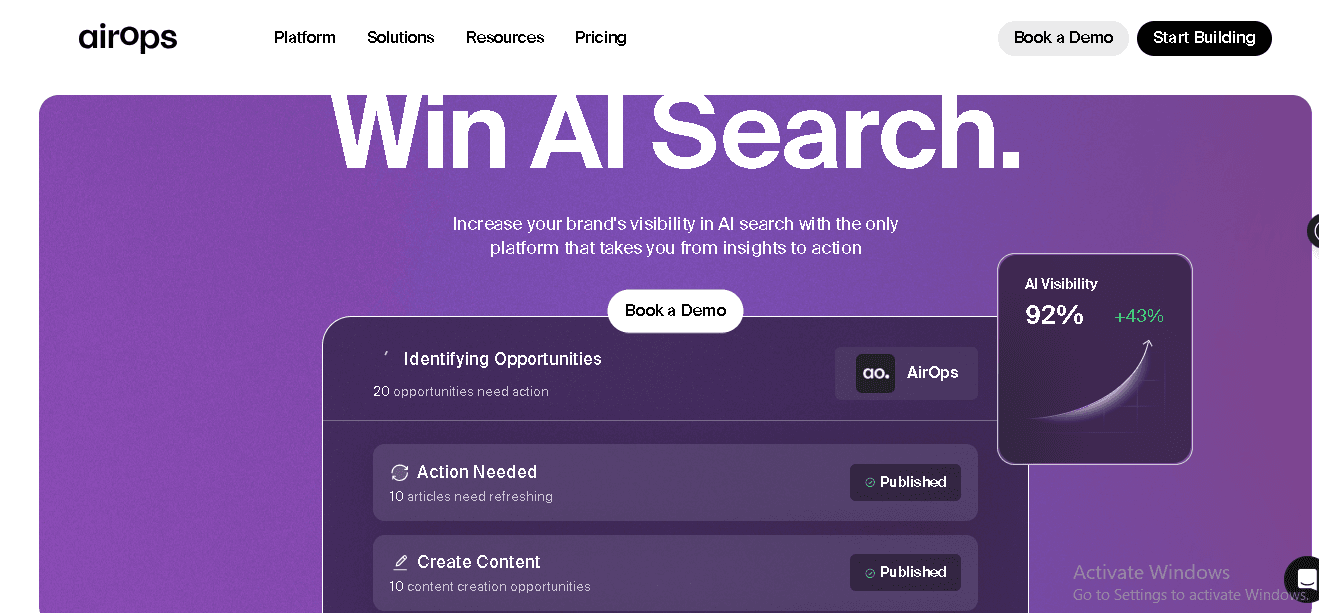
Why AirOps Stands Out
AirOps is built for scalability and precision. It helps you automate SEO tasks that normally take hours — from keyword clustering to content publishing — while preserving your brand tone and strategic direction.

You can build workflows, train models on your brand voice, or use done-for-you templates built on SEO best practices. It’s designed for content professionals who want complete creative control without touching code.
How AirOps Works
- Start with a Brand Kit: Add your website URL, and AirOps automatically builds a customized brand kit — including tone, mission, and voice.
- Automate SEO Workflows: Use ready-made templates or create your own to build content briefs, article outlines, and internal linking tasks.
- Generate Content: Write long-form articles or landing pages with your tone and voice baked in. AirOps uses live data from SEMrush and Google for contextual accuracy.
- Publish Instantly: Connect your CMS (WordPress, Webflow, Shopify, or Strapi) and push content live directly from the platform.
- Collaborate Easily: Share deliverables through Slack or Google Docs, and fix any automation issues instantly using the built-in AI Copilot.

Key Features
1. Build AI Workflows with 40+ Models (GPT-4, Claude, Gemini & more)
You’re not locked into one LLM. In AirOps, each step in your workflow can call the best model for that job (e.g., Claude for long reasoning, GPT-4 for crisp copy, Gemini for fast ideation). You can chain steps—SERP scrape → cluster → brief → outline → draft → internal-link map → CMS publish—and run them for one page or thousands.

Why it matters: You remove bottlenecks. Instead of bouncing between tools and exporting CSVs, you orchestrate the entire content ops pipeline in one place and scale it with a click. Pro tip: Create two variants of the same step (e.g., GPT-4 + Claude) and A/B which output hits your voice and factuality standards better, then lock in the winner.
2. Brand Kit (Train the Models on Your Voice & POV)
Paste your site URL and AirOps builds a Brand Kit—tone, style, positioning, audiences, taboo phrases, differentiators—then you refine it. Every generation references this profile so drafts sound like you and reinforce your unique POV.
- Why it matters: EEAT isn’t just facts—it’s consistency. This is how you keep 10 writers, 3 editors, and 4 LLMs sounding like one brand.
- Workflow: Add brand tenets, non-negotiables, example paragraphs you love, and “never say” lists. Then point your blog/landing page workflows to this Brand Kit.
- Pro tip: Create multiple Brand Kits (e.g., sales enablement vs. blog thought leadership) and switch with one toggle per workflow.
3) Zero-Code, Reusable Templates for SEO Tasks
Don’t reinvent the wheel. AirOps ships done-for-you templates (content briefs, outlines, listicles, comparisons, FAQs, product pages). Customize once, then save as your template. Why it matters: You standardize the way you research, brief, and draft—so scale doesn’t degrade quality. Use it for:
- Branded “Best X for Y” templates with standardized evaluation criteria
- Thought-leadership frameworks that ensure POV + original examples
- Update templates that force freshness (new stats, recent products, market shifts)
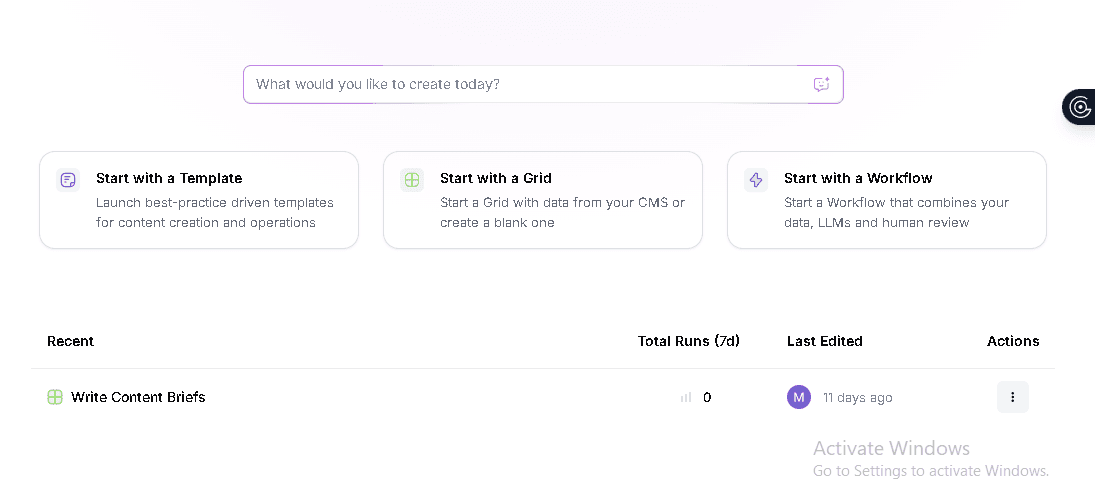
4) Content Briefs with Live SEO Data (SEMrush, DataForSEO, PAA, Reddit)
Start with a topic and AirOps builds a brief from live SERPs: headings competitors use, People Also Ask, Reddit threads, related queries, secondary keywords, intent, and suggested internal links.
- Why it matters: Writers don’t guess. They see exactly what wins now—and what to add to outrank it.
- Workflow: Topic → brief workflow runs → you get a doc with structure, questions to answer, sources, URL slug, meta ideas, and linking plan.
- Pro tip: Add a “What we believe” section to every brief so your team bakes in brand POV—this is how you avoid generic AI copy.
💰 AirOps Pricing — Flexible Plans for Every Team
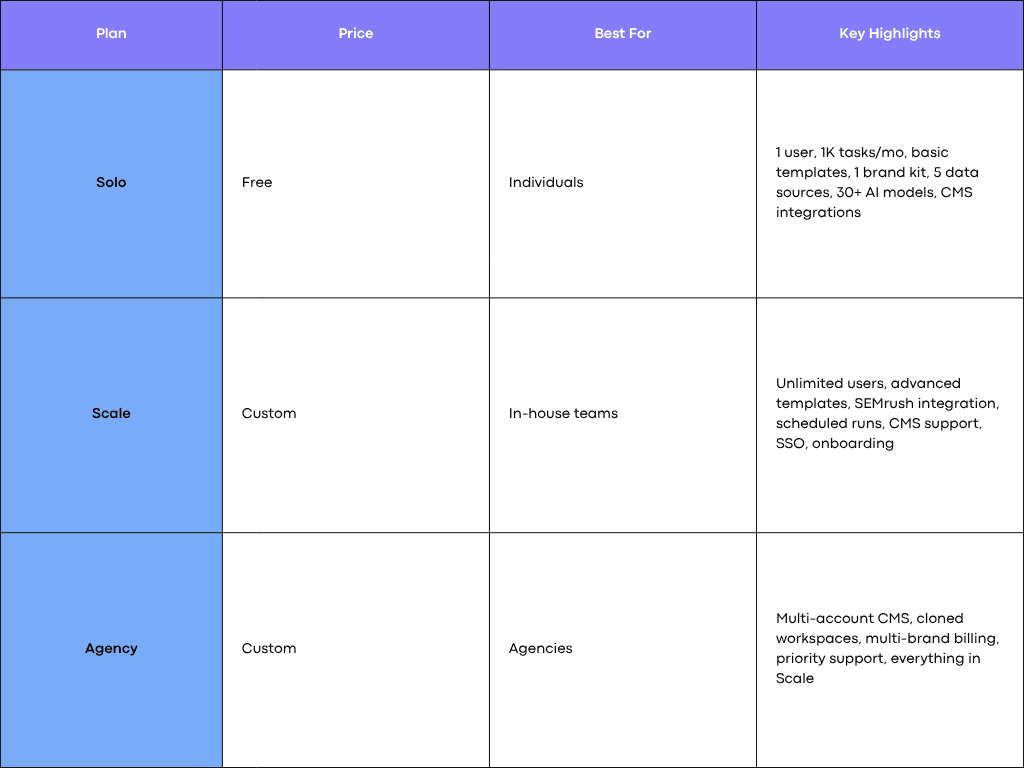
✅ All plans include GPT-4, Claude, Gemini, and other models, plus integrations with WordPress, Webflow, Shopify, Google Docs, and Slack.

Rankscale.ai
Rankscale.ai is a next-generation Generative Engine Optimization (GEO) platform built to track your brand’s visibility across AI search engines like ChatGPT, Perplexity, Claude, and Google’s AI Overviews. Unlike traditional SEO tools that focus solely on Google rankings, Rankscale measures how your content performs inside AI-generated responses — showing where, how often, and in what context your brand appears.
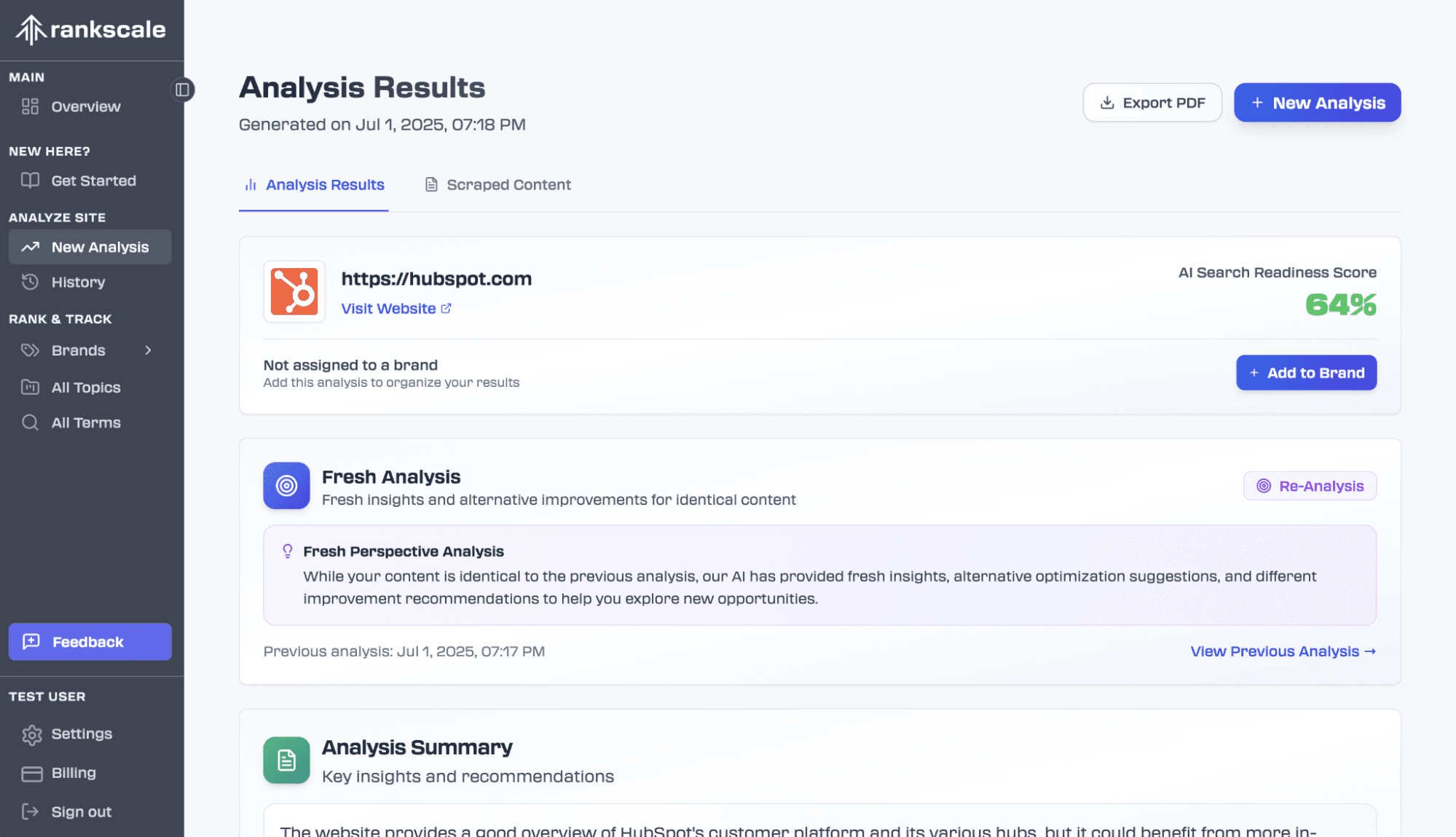
The platform solves one of AI search’s biggest problems: lack of specificity. While other tools show general visibility percentages, Rankscale pinpoints the exact search terms, regions, and engines where your brand is ranking. It’s perfect for SEOs, agencies, and growth marketers who want to understand — and influence — how AI perceives their brand.
How Rankscale Works
After signing up, you begin by running a Brand Analysis. Just input your homepage URL, and Rankscale instantly returns your AI Search Readiness Score, calculated using four critical parameters:
- Content quality and relevance – Evaluates clarity, depth, and alignment with AI search queries.
- Authority and trustworthiness – Measures brand credibility, citations, and backlink quality.
- Technical SEO and structure – Analyzes site crawlability, schema markup, and metadata integrity.
- Engagement – Monitors visitor interaction metrics like dwell time and bounce rate.
Alongside this score, Rankscale provides improvement suggestions, recommended keywords, and a list of competitor domains for benchmarking. Once your brand is analyzed, you can start adding “Search Topics” — these represent product categories, services, or content pillars. From there, you can assign specific search terms, select your preferred AI engines, and define tracking intervals (hourly, daily, or weekly).
Each data point then populates into a rich dashboard showing your AI visibility trends, keyword performance, sentiment analysis, and competitive position.
🔑 Key Features — Fully Explained
1. Track Visibility Across Major AI Search Engines
Rankscale monitors how your brand performs in ChatGPT, Perplexity, Claude, and Google AI Overviews. You’ll see whether your website appears in AI-generated answers, in what position, and with what sentiment. This granular approach helps you identify which engines favor your content, and which require optimization. Pro tip: Use this data to prioritize content refreshes where visibility is dropping — or double down on formats AI tools prefer citing (like “how-to” articles and data-driven posts).
2. Monitor Rankings by Keyword, Engine, and Region
Unlike other GEO tools that deliver vague summaries, Rankscale allows you to track specific keywords across specific AI engines and regions. You can compare your standing for a search term like “best CRM for small business” in ChatGPT (US) versus Google AI Overviews (UK) — with separate visibility scores for each. Why it matters: AI answers are context-sensitive, and this level of detail reveals how language models interpret your brand in different locations and contexts.
3. Sentiment Analysis of AI Mentions
Rankscale goes beyond rankings — it also measures sentiment behind mentions of your brand within AI-generated responses. You’ll know whether AI tools discuss your product positively, neutrally, or negatively, allowing you to monitor brand perception in real time. Example: If Perplexity starts citing your brand negatively, you can analyze which content or reviews triggered that sentiment and address it through improved messaging or citations.
4. Citation and Source Mapping
One of Rankscale’s most impressive features is its ability to show which sources AI engines cite when referencing your brand. You can view the specific URLs, publication names, and timestamps for each citation, revealing how authoritative your content appears to AI systems. Pro tip: Use this insight to identify high-performing content patterns (like expert interviews or long-form guides) that get cited more often, then replicate them across your other pages.
5. Competitor Benchmarking
Rankscale lets you compare your AI visibility scores against competitors — showing who dominates for your target search terms, on which AI platforms, and in which regions. You can view performance charts tracking visibility trends over time, making it easy to spot when a competitor gains traction or starts outranking you in AI responses. This competitive intelligence helps refine your content clustering and link-building strategy based on what’s actually working in AI search.
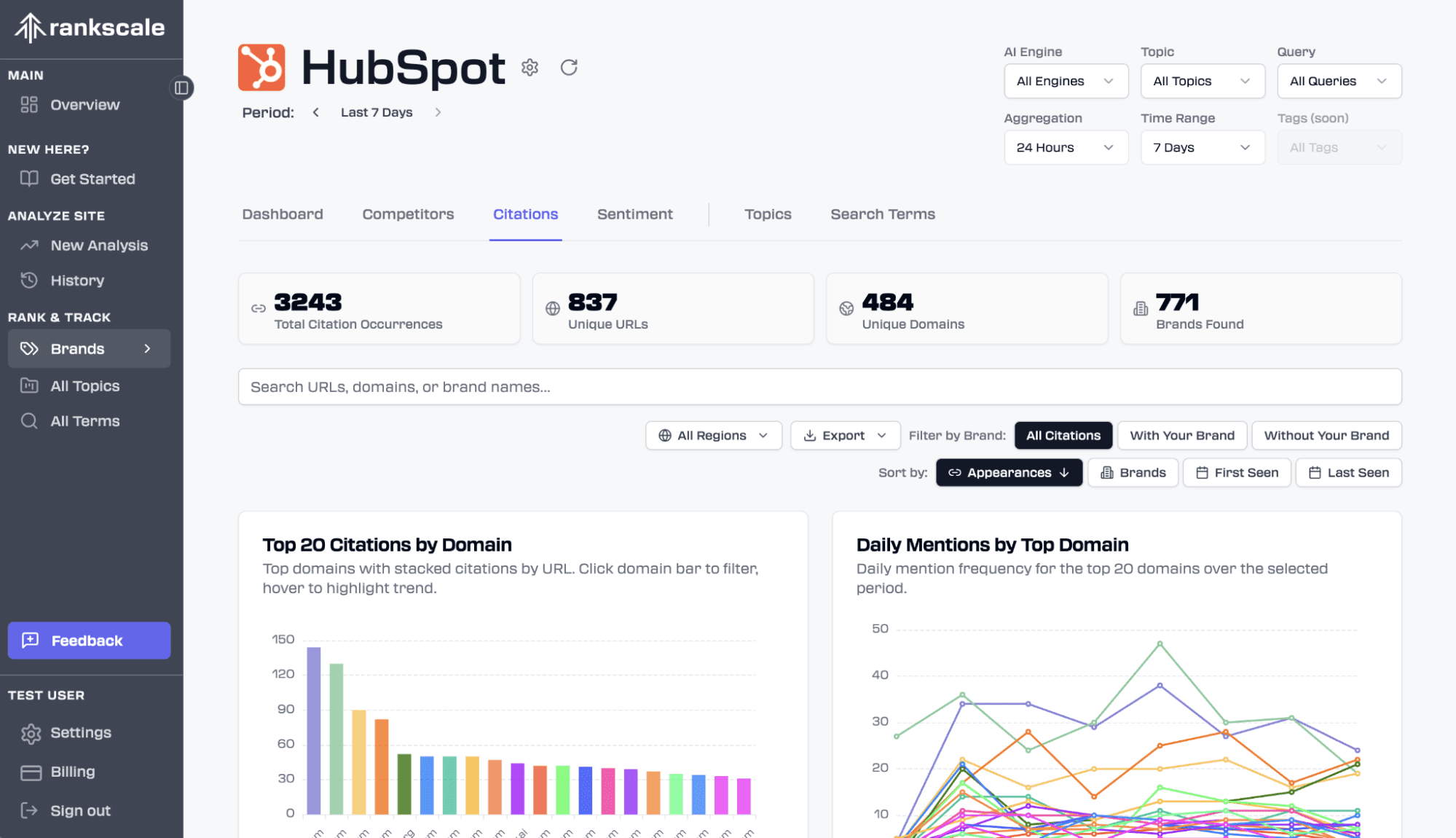
💰 Pricing — Simple and Flexible Credit System
Rankscale uses a pay-as-you-go credit model, which is ideal for agencies and small marketing teams that don’t want long-term commitments. You purchase credits as needed and use them to track specific search terms across engines, locations, and time intervals.


Clearscope
If there’s one SEO tool that has stood the test of time in my workflow, it’s Clearscope. I’ve used it consistently for the past three years, and while many AI tools promise one-click content creation, Clearscope does something far more valuable — it helps you refine your writing so it becomes truly discoverable.
Clearscope is not here to write your article for you — it’s here to help you rank better with data-backed recommendations. It analyzes the top-ranking pages for your keyword, identifies semantic patterns and topic gaps, and tells you exactly what to include to match search intent without keyword stuffing.
Over time, I’ve seen a measurable difference: articles optimized through Clearscope consistently rank higher and faster than those written without it.
In an age of AI-generated content overload, Clearscope’s human-first approach is its biggest strength — it helps you keep your writing authentic while ensuring it performs exceptionally well.

⚙️ How Clearscope Works
Using Clearscope feels intuitive from start to finish. Here’s the typical workflow:
Run a Content Report Enter your target keyword, and Clearscope instantly scans the top-ranking results on Google. It analyzes hundreds of data points to understand what makes those pages rank, then generates a Content Report highlighting the most relevant terms, entities, and topics to include.
See What to Include Inside the report, you’ll find:
- A list of related keywords and semantic variations
- Target word count and readability range
- “People Also Ask” questions for structuring FAQs
- A live content score that updates as you write
Write and Optimize in Real-Time You can write directly inside Clearscope or in Google Docs using the Clearscope extension. As you type, your text is evaluated in real time for keyword coverage, structure, and readability.
Collaborate Across Teams Assign reports to team members, comment in real time, and track optimization progress. It’s built for agencies and editorial teams managing large volumes of content.
Refine, Publish, Track Once your content hits the scoring benchmark (typically A or A+), export or publish it directly. Clearscope ensures every article aligns with the top SERP signals — clarity, depth, and semantic relevance.
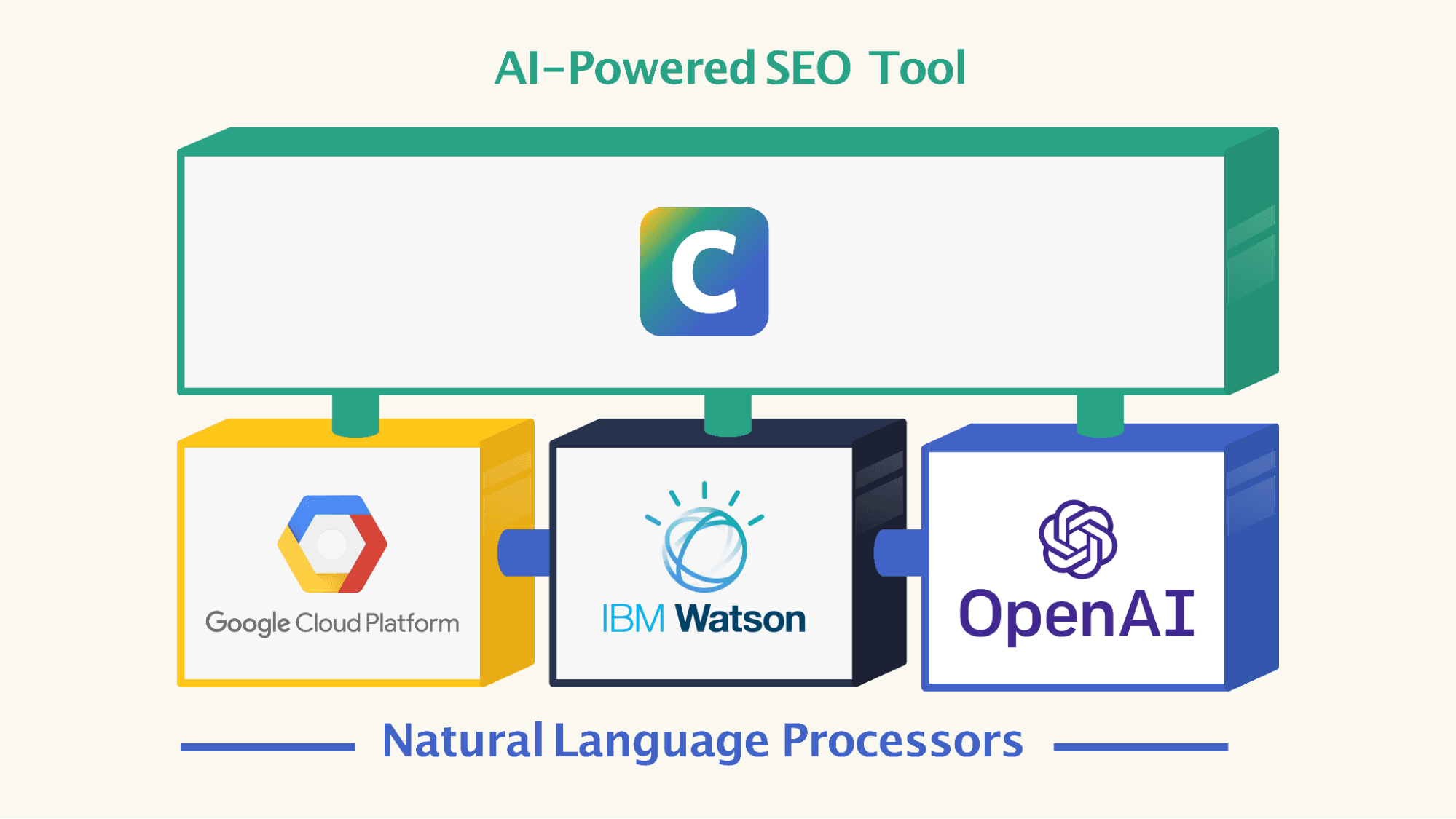
🔑 Key Features — Fully Explained
1. Keyword & Readability Suggestions from Top SERPs
Clearscope’s algorithm crawls the highest-ranking pages for your keyword and distills the most statistically significant terms. You’ll get a list of primary, secondary, and contextual keywords that fit naturally into your writing — along with a readability benchmark based on what’s currently performing well.
Why it matters: Instead of guessing, you know exactly what search engines consider relevant. It’s not about keyword density; it’s about semantic completeness. By using Clearscope’s suggestions, you ensure your content answers every sub-intent behind a query.

2. Live Content Scoring While You Write
The live scoring system is Clearscope’s secret weapon. As you draft, your score updates automatically based on keyword use, structure, and reading ease. An A or A+ score means your piece aligns with top competitors in terms of topical coverage.
Example: If your blog ranks B+ for “AI content strategy,” Clearscope might suggest adding related terms like “content automation,” “EEAT optimization,” or “topic clusters” to bridge semantic gaps.
Pro Tip: Don’t chase a perfect score blindly. Focus on quality, flow, and value — Clearscope rewards natural inclusion, not robotic repetition.

3. Search Intent Matching with Topic Suggestions
Clearscope’s Topic Research and Intent Matching modules help you move beyond single keywords to full-fledged content clusters. The tool highlights what readers expect to find under your topic, ensuring your structure aligns with search intent — whether it’s informational, transactional, or comparative.
Why it’s powerful: This feature transforms your editorial planning. You can identify new supporting posts, internal links, and FAQs to build a complete topical authority network.

4. Google Docs Integration (Real-Time Sidebar Optimization)
One of Clearscope’s most underrated features is its Google Docs sidebar integration. You can optimize directly inside your document — no need to copy and paste between tools.
How it helps:
- Keywords you’ve covered are highlighted in real time.
- You can see readability and content grade instantly.
- Team members can collaborate and edit with live feedback.
For me, this integration is game-changing. It keeps my workflow simple, distraction-free, and ensures I never lose version control across docs.

5. Team Collaboration Tools
Clearscope isn’t just a solo writer’s tool; it’s built for teams. You can assign reports, tag collaborators, leave inline comments, and track completion rates for every article.
It’s especially useful for content managers and SEO leads overseeing multiple writers — no more messy spreadsheets or manual tracking. Everything from ideation to publication lives in one ecosystem.
6. Multi-Language Optimization Support
Beyond English, Clearscope supports Spanish, Germa
n, French, and more. It adapts its keyword and readability recommendations based on the linguistic norms and search intent of each market.
Why it matters: If you’re scaling globally or running multilingual blogs, Clearscope helps you maintain optimization consistency across markets — all within a single account.
7. AI Cited Pages (New 2025 Feature)
In 2025, Clearscope introduced “AI Cited Pages,” a feature that shows exactly which pages are being referenced by AI systems like ChatGPT and Gemini. This bridges the gap between SEO and AEO (Answer Engine Optimization) — helping you track your discoverability across both search and generative platforms.
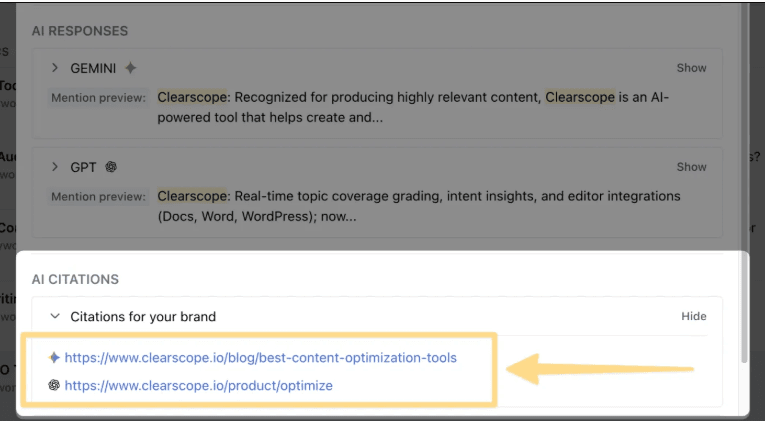
Practical use: You can see whether AI models are pulling data from your articles — and if not, what kind of content they tend to cite. That insight helps you reverse-engineer authority signals and create more citation-worthy pages.
Clearscope Pricing
Clearscope’s pricing reflects its premium positioning — it’s made for professionals who prioritize quality and performance. Every plan includes free onboarding, unlimited sharing/exporting, and full customer support.

While Clearscope sits at the higher end of the market, its data accuracy, ease of use, and proven ranking impact more than justify the cost. You’re not paying for automation — you’re paying for clarity and results.
Clearscope bridges traditional SEO and the new frontier of Answer Engine Optimization (AEO). Its AI visibility tracking, semantic depth analysis, and human-first optimization ensure your content stays competitive — not just in Google, but also across AI chat interfaces like ChatGPT and Gemini.
Unlike AI-only writing tools that prioritize speed, Clearscope focuses on strategic craftsmanship — helping humans write better, smarter, and faster using real search data.

Conclusion
Choosing the Best AI SEO Tools isn’t just about automation — it’s about amplifying your expertise. Each platform in this list helps you do exactly that. With AISEO, you can humanize AI-generated content and create SEO-ready articles that rank naturally. Semrush gives you unmatched data insights for keyword and competitor analysis, while SurferSEO helps you fine-tune every article for top performance. Keyword Insights takes a data-driven approach to clustering and intent mapping, and SEOwind streamlines content briefs and updates using EEAT-focused AI workflows.
When you combine these tools, you’re not just optimizing for Google — you’re building topical authority, visibility, and trust across AI-powered search engines too. The future belongs to marketers who use AI to work smarter, not harder. Start integrating these Best AI SEO Tools today and transform how you plan, write, and rank.
Frequently Asked Questions About the Best AI SEO Tools
1. What are the Best AI SEO Tools for 2025?
The Best AI SEO Tools in 2025 include AISEO, Semrush, SurferSEO, Keyword Insights, and SEOwind. Each tool brings something unique to the table:
- AISEO specializes in generating and humanizing AI-written content to bypass AI detection while maintaining natural readability.
- Semrush remains the industry leader in comprehensive SEO data, keyword analytics, and competitor insights.
- SurferSEO helps you optimize content based on data-driven recommendations, keyword density, and entity use.
- Keyword Insights uses SERP-based clustering and intent analysis to help you build topical authority.
- SEOwind focuses on automated content briefs, EEAT scoring, and SEO-driven updates. Together, these AI SEO software solutions form a complete ecosystem for keyword research, on-page optimization, and AI-powered visibility tracking across Google and AI search engines.
2. How do AI SEO Tools help you improve Google rankings?
AI SEO tools analyze vast amounts of search and user data faster than any human can. By using these insights, you can make smarter, more precise optimizations. For example, AISEO refines your text to sound more human while staying SEO-friendly. SurferSEO suggests exactly which keywords, entities, and internal links to add for top-ranking content. Meanwhile, Semrush and Keyword Insights uncover untapped keyword opportunities, track competitors, and prevent keyword cannibalization. With these tools, you can publish content that satisfies Google’s E-E-A-T (Experience, Expertise, Authoritativeness, and Trustworthiness) standards — and boost your visibility in both organic and AI-driven search results.
3. What is the difference between traditional SEO tools and AI SEO tools?
Traditional SEO tools like Semrush and Ahrefs rely heavily on historical keyword data, backlinks, and search volume trends. They excel at tracking rankings, analyzing websites, and conducting competitor research. AI SEO tools, on the other hand, go a step further — they use machine learning and natural language processing to predict search intent, automate optimization, and generate content tailored to user needs. Tools like AISEO and SEOwind don’t just help you analyze performance; they actually assist in writing and structuring content that’s primed to rank. In short, traditional tools tell you what to do, while AI SEO tools help you do it faster and smarter.
4. Can AI SEO tools write entire articles for you?
Yes, but with a caveat. AI SEO tools like AISEO, SEOwind, and SurferSEO can generate entire articles — but they work best when you add human input and editing.
AI can handle the heavy lifting: research, outlines, keyword clustering, and initial drafts. However, to meet Google’s E-E-A-T standards and ensure your content reflects genuine expertise, you should always review, refine, and personalize what AI produces.
Think of these tools as co-writers, not replacements. When you combine AI’s speed with your own experience and tone, you get content that both ranks well and resonates with readers.
5. How do AI SEO tools handle keyword clustering and intent mapping?
Keyword clustering and intent mapping are two of the most valuable applications of AI in SEO. Tools like Keyword Insights and SEOwind analyze search engine results pages (SERPs) to determine which keywords share similar intent.
For example, if “best budget running shoes” and “top affordable running shoes” return the same top-ranking URLs, the AI knows they belong in the same cluster. This prevents keyword cannibalization — where multiple pages compete for the same search term — and helps you build topical authority by covering related topics in one cohesive strategy. Intent mapping ensures you’re matching the right content type (informational, commercial, or transactional) with the right audience need.
6. Which AI SEO tool is best for content optimization?
If your main goal is to optimize existing content, then SurferSEO and SEOwind are your best options.
- SurferSEO provides a real-time optimization score, highlighting missing keywords, internal links, and structure gaps compared to competitors.
- SEOwind helps you update old or underperforming articles with its Content Update Engine, which evaluates relevance, keyword freshness, and EEAT signals. Meanwhile, AISEO ensures the content remains natural and undetectable as AI-generated, which is crucial for maintaining trust with both Google and readers. Using these tools in combination ensures your articles stay fresh, authoritative, and AI-visible.
7. How does AISEO differ from other AI writing tools?
Most AI writing tools simply rephrase or spin content, but AISEO goes much deeper. It’s designed not only to generate SEO-friendly text but also to humanize AI content, ensuring it passes AI detection tools like GPTZero or Copyleaks.
It uses contextual rewriting, semantic optimization, and brand voice alignment to create authentic, engaging content. Moreover, AISEO’s LLMs.txt generator helps websites prepare for AI indexing — a major advantage as search shifts toward AI-driven answer engines like ChatGPT and Perplexity. In short, AISEO doesn’t just make your writing faster; it makes it future-proof.

About Dilyar Buzan
Founder & CEO at AISEO
Artificial Intelligence - University of Amsterdam
LLM engineer
